GETTING

BEEF CATTLE CHECK-OFF INCREASE APPROVED WITH STRONG SUPPORT FROM DELEGATES

GETTING

BEEF CATTLE CHECK-OFF INCREASE APPROVED WITH STRONG SUPPORT FROM DELEGATES

HIDDEN-VIEW POLLED HEREFORDS
Joe and Karen Paszternak NORWOOD, ON 705-9573739 or 705-957-7470 karen.paszternak@gmail.com Bulls for sale
JDL CATTLE CO. & D&S LIVESTOCK
David & Shirley Lasby
Josh Lasby, Justin & Jaimie Lasby & Family, Jessica Lasby & Travis Fulford & Family MULMUR, ON 519-943-4147 or 519-278-6819
jessica.lasby@hotmail.com
Good-looking, Sound, Functional Cattle!
LIAN MOR POLLED HEREFORD
Wally & Fern Pugh MONO, ON
Wally & Fern Pugh lianmor48@gmail.com · 519-941-8515
Trevor & Amy tpugh27@yahoo.com · 519-939-7489
Breeding Stock Available
MEDONTE HIGHLANDS POLLED HEREFORDS
3055 Universal Dr. Mississauga, Ontario (905) 625-3151
maria@standardmechanical.com
“6 Star Breeder”
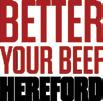
O’SHEA FARMS
Jamie and Mel O’Shea DENFIELD, ON 519-477-1238
osheafarms@hotmail.com Bulls and Females for sale
WHISKEY LANE LIVESTOCK
Herford and Angus Scott, Paula, Jason and Shelby Cornish INDIAN RIVER, ON 705-295-2925
705-878-3248 (Scott’s Cell) 705-341-3220 (Paula’s Cell) wll@nexicom.net
Visitors Always Welcome


This spring, BFO, with funding from the Beef Cattle Research Council, hosted a couple of sessions on getting back to the basics of beef production where speakers and attendees spent the day focused on the fundamentals of cow-calf production and reviewed practices that can have a positive impact on the reproductive and performance efficiency of each calf crop. You can read more about the two events on page 16. In this issue of Ontario Beef, you will also find detailed reports from our annual meeting, the result of the proposed check-off increase and next steps, as well as a highlight of our special award winners. Lastly, BFO President Craig McLaughlin joined a panel discussion following Alltech’s first-ever Canadian screening of its documentary A World Without Cows. The film provides a balanced, global perspective on the relationship between cows and the environment. Read more about the documentary and its premiere on page 26.
Don’t miss out on submitting your photos for our August issue. Please send your summer-inspired photos by July 15 to be considered for the cover. Digital photos in portrait orientation that are at least 300dpi are preferred, and can be emailed to
ONTARIO BEEF • Beef Farmers of Ontario 130 Malcolm Road, Guelph, ON N1K 1B1 • Phone: 519-824-0334 • Toll Free (for Ontario callers only) 1-866-370-BEEF (2333) Fax: 519-824-9101 • info@ontariobeef.com
EDITOR
LeaAnne Wurmli
CIRCULATION COORDINATOR
Charlene Yungblut
ADVERTISING MANAGER
Cathy Lasby, Preferred Agri-Marketing Services
Guelph, ON Phone: 519-763-8833 • Fax: 519-763-8833 pams@sentex.net
DESIGN and LAYOUT
Prism Studios Advertising and Design Inc. Guelph, ON
PRODUCTION and PRINTING
Beck’s Printing Services, Brantford, ON
PROVIDING A FORUM FOR THE ONTARIO BEEF INDUSTRY
Ontario Beef is the official publication of the Beef Farmers of Ontario. Contents of this publication may be reproduced only by permission of the Editor and with credit acknowledged.
Opinions expressed herein are those of the author and/or editor and do not necessarily reflect the opinion of the Beef Farmers of Ontario. Publication of advertisements does not constitute endorsement or approval by Ontario Beef or the Beef Farmers of Ontario of products or services advertised.
Advertising deadlines are January 10, April 15, July 15, September 15 and November 15. The publisher reserves the right to refuse or cancel any advertising, including advertising that is inconsistent with BFO’s Sponsorship Policy, available at www.ontariobeef.com. Every effort is made to ensure the accuracy of material published, however no responsibility can be assumed for advertising not received in clear, type-written form.
Canadian Publications Mail Product Sales Agreement Number 0040007029
POSTMASTER: Return undeliverable Canadian addresses to: Beef Farmers of Ontario, 130 Malcolm Road, Guelph, ON N1K 1B1

By Craig McLaughlin, BFO President info@ontariobeef.com • www.ontariobeef.com
I mark my first trip around the sun as president and enter my ninth and final year on the board, I am met with many thoughts and reflections, but rising tensions with our closest trading ally was certainly not on my bingo card a year ago. As I mentioned in my previous column, there has been no shortage of hot topics facing the Ontario and Canadian cattle sectors with tense trade relations with the U.S., a provincial election and new Ontario agriculture minister, and a federal election and new prime minister here in Canada.
Keeping up with the news and political developments has been a daily, and on some days, an hourly task. The silver lining of the busy meeting season has been the windshield time spent travelling the province and regular news updates on the radio.
Soon following BFO’s AGM, I attended the first-ever Canadian screening of Alltech’s documentary, A World Without Cows, which provides a balanced, global perspective on the relationship between cows and the environment. Following the screening, I joined a panel discussion with a number of individuals to reflect on the film with moderated questions from Kelly Sommerville, CEO of the Livestock Research Innovation Corporation (LRIC). You can read more about the film and our discussions on page 26.
After our March board meeting, Mike Schreiner, Leader of the Green Party of Ontario, visited our office where we had the chance to connect post-election and have a candid conversation on the impact of the U.S. tariff threat on the Ontario beef sector. I also attended a number of annual meetings in the following weeks - the Ontario Feeder Finance AGM, the Veal Farmers of Ontario AGM and the Farm & Food Care AGM, all of which were in Elora, and then I
BFO BOARD OF DIRECTORS 2025
Craig McLaughlin (Eastern Director) – President
Phone: 613-504-1863 • Email: cmblackhorse@gmail.com
Jason Leblond (Northern Director) – Vice President
Email: jacres5@gmail.com
Don Badour (Cow-Calf Director)
Email: don.badour@gmail.com
Don Hargrave (Cow-Calf Director)
Email: dchargrave@gmail.com
Jim Whitley (Cow-Calf Director)
Email: modelaranch@hotmail.com
Joost van der Heiden (Background Director)
Email: jcvdheiden@hotmail.com
Nick Martin (Feedlot Director)
Email: nickolas@pureislandbeef.com
Jairus Maus (Feedlot Director)
Email: ellengowanfarms@gmail.com
Tom Kroesbergen (Feedlot Director)
Email: tomkroes50@hotmail.com
Denise Byers (Southern Director)
Email: byersdimmick@yahoo.com
Ralph Eyre (Director-At-Large)
Email: ralph@eyrefarms.ca
Kim Jo Bliss (Director-At-Large)
Email: kimjobliss@gmail.com
Emily Bromley (Youth Director)
Email: fondoak@live.ca
travelled east to Ottawa for the Canadian Cattle Association AGM where I was joined by BFO directors Jason Leblond, Jim Whitley and Don Hargrave.
Along with BFO Executive Director, Richard Horne, I attended the Grow Ontario Food Summit in Guelph hosted by the Hon. Trevor Jones, Ontario’s new Minister of Agriculture, Food and Agribusiness. We had the opportunity to connect with Minister Jones to congratulate him on his recent appointment, and extend our appreciation for the increased funding commitment to Ontario’s Risk Management Program and our eagerness to see its implementation. We also received Minister Jones’ support to proceed with our 17th annual beef barbecue at Queen’s Park, which is an event launched in 2003 as a way to thank politicians for their support during the BSE crisis. The event is scheduled, rain or shine, on May 28th, where we will invite all MPPs and their staff for an Ontario beef lunch, and meet with MPPs individually throughout the day to discuss beef sector priorities.
I’ve also been fortunate to attend a number of producer meetings over the last several months. In April, I attended BFO’s Back to Basics event in Selby, which I felt was an extremely worthwhile and engaging event and I hope to see us host more events like this with an emphasis on information sharing and good discussion. You can read more about the events on page 16. Later in the month, I headed north for Matheson to attend and participate in the Northeastern Beef Symposium. This was my second time attending this event, which was very well attended and organized. Following the meeting, I was fortunate to spend some time touring the area with Jason Desrochers, a local beef farmer
BFO STAFF
Executive Director
Richard Horne • richard@ontariobeef.com
Manager of Policy and Issues
Thomas Brandstetter • thomas@ontariobeef.com
Policy Advisor
Evan Chaffe • evan@ontariobeef.com
Director of Communications
LeaAnne Wurmli • leaanne@ontariobeef.com
Manager of Public Engagement and Digital Strategy
Jennifer Kyle • jennifer@ontariobeef.com
Engagement Coordinator
Charlene Yungblut • charlene@ontariobeef.com
Member Information Coordinator
Jamie Gamble • markets@ontariobeef.com
Accountant
Amber McIntyre • amber@ontariobeef.com
Office Manager
Lisandra Lima • lisandra@ontariobeef.com
Manager of Producer Relations & Director of the Ontario Beef Youth Alliance
Jaclyn Horenberg • jaclyn@ontariobeef.com
Senior Producer Relations Advisor
Dan Ferguson • dan@ontariobeef.com
Producer Relations Specialist
Robert McKinlay • robert@ontariobeef.com
Manager of Compliance
Chris Millar • chrism@ontariobeef.com
Supervisor of Provincial Programs
Barb Caswell • barb@ontariobeef.com
and advisory councillor for the Cochrane region. It was amazing to see the agriculture development and growth in the area since my last visit a number of years ago, and I appreciated Jason’s time and hospitality. Locally, I participated in a couple of meetings with producers from Renfrew County and the surrounding area. The first meeting was hosted by Cyndi Mills, the federal Liberal candidate for the riding of Algonquin-Renfrew-Pembroke, who was joined by Kody Blois, Minister of Agriculture and Agri-Food Canada. The second meeting I attended was with the Arnprior Federation of Agriculture who held their annual breakfast meeting in Pakenham.
On a more somber note, this month marks the 25th anniversary of the Walkerton water crisis. The devastating major public health event occurred in 2000 when the town of Walkerton, Ontario, experienced a severe E. coli contamination of its drinking water supply, which sadly led to seven deaths and over 2,300 people becoming ill. At the time, agriculture and livestock production and its impact on the environment and public water supplies was in the spotlight and under the microscope. The work of BFO (formerly the Ontario Cattlemen’s Association) and its leadership, led by president Stan Eby at the time, is still revered as a blueprint on how to deal with environmental issues and crisis situations. Stan dedicated his time to supporting the livestock sector and beef farmers while undertaking hundreds of media interviews, as an opportunity to speak to the public about farmers’ commitment to environmental stewardship and water quality.
Over the last several decades, we’ve experienced a tremendous shift in the role of farmers and the leadership of the agriculture sector to speak confidently about the responsible environmental practices used on farms and within the farming community. The beef sector has always been engaged in the shaping of environmental legislation like the Clean Water Act, the Nutrient
Management Act and the Species at Risk Act, and leading and supporting industry initiatives like the Environmental Farm Coalition, the Environmental Farm Plan, the Canadian Roundtable for Sustainable Beef, the environmental components in our quality assurance programs, as well as recognition efforts like the annual Environmental Stewardship Award.
Speaking of strong leaders, BFO Past President Jack Chaffe and current director and member of the BFO executive team, Kim Jo Bliss, were recognized for their leadership and contributions to Canada by each receiving the prestigious King Charles III Coronation Medal presented by their local MPPs last month. We’re lucky to have such strong ambassadors within the beef sector and they are both very deserving of the recognition.
As I close, I would like to extend my personal thanks and congratulations on a well-deserved retirement to Cheryl Russwurm who retired in March. Cheryl joined BFO close to 20 years ago as the Provincial Program Supervisor for feeder and breeder finance, and the Advance Payments Programs. During Cheryl’s tenure, she saw and helped implement many positive changes to these programs, she watched the feeder program alone grow from an $80 million dollar lending cap in 2006, to a $500 million dollar lending cap today. She oversaw multiple program reviews, and led BFO’s efforts throughout those discussions, fighting for the best outcomes for co-ops, beef members, and the industry at large.
Cheryl’s knowledge and experience will certainly be missed, and we sincerely thank her for 19 years of service in support of beef farmers, the association, and the Ontario beef sector.
With the busy season upon us, stay safe around equipment and livestock, and don’t forget to take the time to recharge your own personal batteries.
Beef farming: Only for the brave. OB



By Evan Chaffe, BFO Policy Advisor evan@ontariobeef.com • www.ontariobeef.com
it comes to Canadian politics, to say the start of 2025 has been interesting is putting it lightly. We’ve witnessed a change in Prime Minister, experienced tariff threats from the U.S., and went to the polls for federal and provincial elections, all in the span of a few months. Beef Farmers of Ontario (BFO) has taken this time to compare the priorities of the two newly formed governments and our priorities to develop a strategy so we can advocate more effectively on behalf of our members.
At the end of February, Premier Doug Ford and the Progressive Conservative Party of Ontario were elected to a third majority government where they hold 80 of the 124 seats at Queen’s Park. Premier Ford later announced his Cabinet, which resulted in the Hon. Trevor Jones stepping into the role of Minister of Agriculture, Food and Agribusiness to replace Minister Rob Flack who became Minister of Municipal Affairs and Housing. Minister Jones is not a new face to agriculture as he previously served as the Parliamentary Assistant to OMAFA from June 2022 to March 2024 under Minister Lisa Thompson.


THANK YOU to our bull buyers in Saskatchewan, Manitoba, and particularly our loyal Ontario customers. For over 50 years we have been supplying bulls all across Canada, and seven other countries. GOOD NEWS... we have a powerful new crop of bull calves. It is never too early to reserve your bull needs for next year. Note: Our herd is gnomically tested, and selected for tenderness since 2008. No one ever regretted buying quality.
DON & JEANNETTE CURRIE
2234 Conc. 11, R R #1, Nottawa, Ontario L0M 1P0
Phone/Fax: 705-445-1526
Cell: 705-715-2234 • Email: doncurrie@glenislay.com

Another significant change is the tariff threats we have been experiencing from our neighbours south of the border, and because of those threats, we’re starting to see the provincial government focus more on domestic production and ensuring the protection of critical sectors within the province. The tariff threats are very unnerving for the beef sector, but the situation does provide the opportunity to position the beef sector in Ontario as a pillar of domestic strength within the province as we contribute $3.23 billion to Ontario’s GDP and 58,598 jobs in Ontario.
Looking towards the end of this month, BFO is hosting its spring lobby day in conjunction with our annual Queen’s Park Barbecue on May 28th. BFO has several issues we look forward to bringing to the attention of all MPPs at Queen’s Park, and solutions we feel will help strengthen the Ontario beef sector in these turbulent times.
As with any lobby day, our messaging and conversations will be focused to ensure consistency and greater traction for our requests. First, we will be expressing our appreciation to the Government of Ontario for the additional $100 million that was committed to Ontario’s Risk Management Program (RMP) at the end of January. We continue to advocate that RMP is one of our most effective tools to help farmers mitigate increased market volatility and, not to mention, the unprecedented tariff risks.
Our second priority is to help us grow our grazing sector, support our grasslands and assist new and younger farmers with the cost of entry and expansion through a government-backed loan guarantee under our Ontario Beef Breeder Cattle Loan Program. The goal is to have the Breeder Cattle Loan Program mirror success we’ve seen with its sister program, the Ontario Feeder Cattle Loan Guarantee Program, which, for more than 25 years, has never had a call on the province’s guarantee.
Our final priority for the day will be to propose solutions to address the large animal veterinary shortage. Our request is to double the investment in the Vet Assistance Program (VAP) from $800,000 to $1.6 million per year and ensure the new collaborative DVM program with Lakehead and the University of Guelph gets up and running to secure a larger pipeline of food animal veterinarians to serve the needs of Ontario.
Continued on page 8.

the movement alongside feedlots across Canada who are improving air and water quality by reducing ammonia gas emissions in more than 1 million head of cattle*.
Of course, we will be meeting with a number of MPPs who are responsible for specific files within the government. This opportunity will provide us with the ability to target some of our other priorities with Ministers, Parliamentary Assistants or MPPs where it will be most effective. Those issues include:
• Working with BFO to enact immediate changes to the Beef Cattle Marketing Act (BCMA) to remove current exemptions and implement the increase in the check-off levy BFO members approved with overwhelming majority this past February.
• Improve transparency in the carcass condemnation decision-making process. BFO will also be pushing for an OMAFA report outlining why provincial abattoirs have condemnation rates significantly greater than federally inspected plants, and actions that can be taken to reduce the disparity between the two systems.
• Introducing property tax relief measures for food processors, particularly abattoirs, or other targeted measures to help reduce the tax burden on domestic processors of food.
• Conducting a review of the PAWS Act. BFO will also advocate for developing a livestock-specific regulatory framework distinct from zoos, aquariums, and companion animals, similar to what other jurisdictions have done.
As I write this, the federal election has just concluded, and with that comes some uncertainty. We know the priorities and promises the Liberal Party of Canada established within their platform, but how those are rolled out is up for debate. The Liberal Party is now entering its fourth term as the governing party of Canada, but this time with a new leader, Prime Minister Mark Carney. With the Liberal Party securing a minority government, it means they must work with the other parties to accomplish their key priorities.
Some of the key agriculture priorities the Liberal government outlined in their platform, which could be relevant to the beef sector, included:
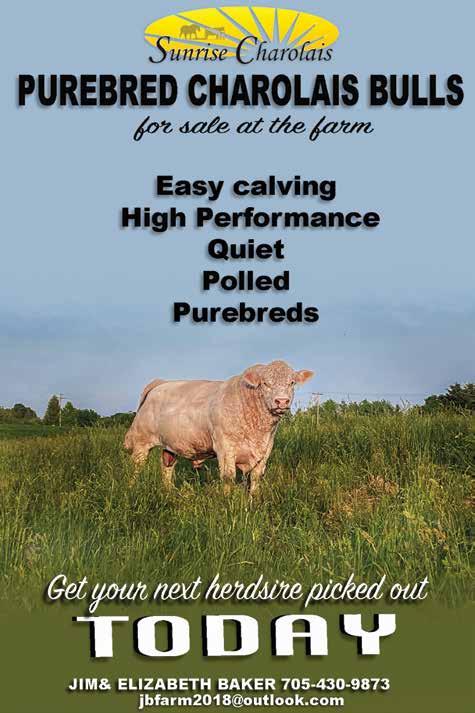
• Making permanent the doubling of the revenue protection for farmers under the AgriStability Program, from $3 million to $6 million per farm, in the case of significant revenue drops caused by the impacts of tariffs, extreme weather events, and other external shocks.
• Build more domestic processing capacity, including food processing capacity in rural and remote areas, with a new $200 million Domestic Food Processing Fund.
• The Canadian Agricultural Loans Act program’s loan guarantee limit will be doubled from $500,000 to $1 million, and terms will be expanded by 5-10 years.
• Amend the mandates of the Canadian Food Inspection Agency and the Pest Management Regulatory Agency to ensure they consider food security and the cost of food in all their regulatory decisions without compromising health and safety. Currently, these important agencies only look at their respective mandates through a health and safety lens.
• Work with the Canada Food Inspection Agency to ensure mutual recognition of food safety standards with reliable trading partners. This will cut red tape to accelerate access to new technology approvals without compromising health and safety.
With this new federal government, our top priorities have not changed. SRM harmonization, international trade, dealing with potential U.S. tariffs, maintaining the interestfree portion of the Advance Payments Program at a minimum of $250,000, and the removal of the 100-day residency rule with the U.S. and South Korea all remain high priorities for BFO.
Anyone who works with the government knows some of these tasks may take some time; however, rest assured we continue to do everything in our power to get these across the finish line for Ontario beef farmers. Check out our next edition of the Ontario Beef magazine for a recap of our 17th Annual Queen’s Park BBQ and spring lobby day. OB


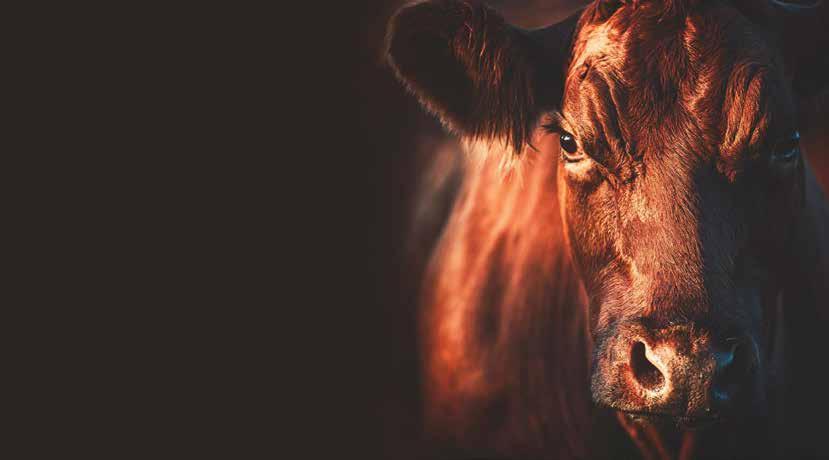
Currently offered as a free, live webinar. Please email jaclyn@ontariobeef.com for upcoming training dates.
AUDIT PREP
During the training webinar, you will learn about the audit requirements. Operations must have at least six months of records for cow-calf producers and three months of records for feedlots.
Schedule an on-farm audit with a trained auditor coordinated through the national office. Complete any Corrective Action Requests from the audit to successfully become a VBP+ Certified operation.
MAINTAIN ACTIVE VBP+ STATUS
Complete yearly record requirements to ensure that you are still in compliance with the program. On-farm audits are completed once every five years.
Ontario feedlots also have the option to be certified under the Ontario Corn Fed Beef Quality Assurance Program through the completion of training, assessments and an on-farm audit.


By Jennifer Kyle, Manager of Public Engagement and Digital Strategy jennifer@ontariobeef.com • www.ontbeef.com
The first quarter of the year is typically quieter on the consumer engagement front as we await final budget approval in March before getting underway with our plans for the year. However, while our coordinated engagement activities were quiet, consumer engagement in general has been front and centre as Trump’s tariffs have created an increased demand for local food.
Even without a campaign running, we have seen increased traffic to our website, particularly the Store Locator page, as Canadians make a sustained effort to source local food and other products. In response, we have made an effort to regularly highlight the locations we have in our map database. This has increased the traffic to the locator, as well as increased the applications to add stores and producers to the map. Since the tariff chaos really took hold in February, we have added more than a dozen new locations, as well as received many requests to update information for existing locations.
As we move forward with our 2025 plans, we have tweaked our plans to accommodate some extra emphasis on the local food movement. Last year we spent a lot of time and resources on creating our general awareness campaign, so the plan is to tweak our messaging and repurpose those awesome assets. We know that the farm content also plays well with our audiences, so we will be looking to add some more farm content to our mix. We also have plans to be back at the CNE, Royal and Breakfast on the Farm events throughout the summer and fall. We will be out in full force encouraging folks to ask for Ontario beef. Stay tuned to our social media channels this summer for the kick-off to the year’s activities. In the meantime, let’s take a look at Q1 of 2025.
to get going on the bulk of our activities, we do still like to have a little
Raising beef is vital to your family, your farm, your community, and Ontario as a whole. The product you raise deserves to reach appreciative family tables close to home, ensuring you receive the best value for your hard work. At VG Meats, we’ve partnered with small beef farmers across Ontario who share our commitment to quality, sustainability, and continuous improvement. Now, we’d like to work with you.
We’re looking to purchase your finished cattle and provide you with valuable data on each animal’s tenderness, yield, quality, and weight. This information not only helps you secure a premium for your beef but also supports better management and genetic decisions for generations to come. By working together, we can help regenerate the lives, profits, and land of Ontario’s beef farming families.

Over the years, we’ve also expanded our connections across Ontario’s retail landscape, creating more opportunities for locally raised beef to reach appreciative consumers. You can learn more about this exciting initiative and how it benefits Ontario farmers at harvesttogather.ca
If your family finishes cattle and you’re ready to explore this opportunity, reach out to me, Cory Van Groningen, at cory@vgmeats.ca, and I’ll share the details of our program. Let’s schedule a time to discuss how VG Meats can help bring your beef to market while supporting your farm’s growth. We look forward to hearing from you soon.






something happening on our channels to go with our everyday, organic social media posts. With this in mind, we always plan one of our “micro” influencer waves for this period so we have a little bit of fabulous new content. For this wave, our challenge for the influencers was to showcase a delicious dish that featured an economical beef cut, as well as highlighting the nutritional power of beef, and encouraging followers to source local, Ontario beef. For our Q1 influencer wave this year, we chose to partner with Valerie Azinge of @mydigitalkitchen. Valerie creates awesome content, so we were excited to partner with her. She created an Ontario Beef Rogan Josh, which is a curry that typically would be made with lamb or goat. The beef version was a big hit on our channels and provided some new inspiration for comfort food and what to do with stewing beef. She did a great job highlighting the nutritional value of beef and encouraging her audience to visit their local butcher or meat counter and ask for Ontario beef. By all accounts, it was another successful wave reaching 456,164 people and making 1,171,068 impressions!
With the new semester underway in February, AgScape was able to line up a number of Think Ag Career Competitions at different schools and community centres across the province. These events are mostly for high school students (sometimes grades 7 and 8 depending on the school) and focus on introducing the students to careers in the agriculture and food sector. We had the opportunity to attend events in Mississauga, Burlington, Cornwall and Elgin County in March and April with a fifth scheduled for St. Catherine’s in May. By the end of the semester, well over 2,000 students will have attended the
Do you have an upcoming event that you would like educational or promotional resources for? Contact Charlene at the BFO office to receive a copy of our Educational and Promotional Resource Guide that outlines all of the great items we have available for educational and consumerfacing events.
Looking to add some BFO or Ontario Beef swag to your collection? You’re in luck! The BFO Pop-Up Shop will be up and running again this year throughout the month of July this summer. Watch our BFO and Ontario Beef channels for more information as we get the items finalized and the details ready to go. There will only be one shop running this year, so don’t miss out! Did someone say Christmas in July?
We will continue to provide updates on all of our consumer engagement work throughout the year via these email updates and in Ontario Beef magazine. In the meantime, be sure to follow us on social media to see what we are up to. OB





By Dan Ferguson, Senior Producer Relations Advisor dan@ontariobeef.com • www.ontariobeef.com
spring has brought political disruption to our marketing plans with the daily tariff challenges dictated by the signed executive orders from our southern border’s leader. Couple that with a federal election and recent Ontario election, and many things seem unpredictable. In addition, Mother Nature delivered to parts of the province, a disrupting ice storm that reminded many of us of the value of being prepared for setbacks.
We do tire of inaccurate predictions, but when forecasters have it right and Mother Nature drops an inch of ice on limbs, lines, livestock and buildings, we knew that something had to give. Our farm and household were out of power for a week. During that time, there were lots of situations that evolved, which required us to be ready with an emergency response - no hydro, no heat, no lights and no water pressure. We trusted our hydro crews to work through their priority list of most needing reservice and, as we are at the end of a service line, we knew we would be without for a while.
Luckily, our son has a Miller welder/generator unit in his pickup truck, so we alternated it between his house, our house, and the barn to keep things hot or cold. It’s no Generac system, but with multioutlet extension cords and jerry cans of gasoline, we were holding our own on selective power supply. I decided to protect the truck from ice buildup and pulled it into the hay barn tight behind my Kubota
with loader and bale spears late on day three. Early the next morning, I went to the barn to start my routine and realized I had locked the key fob in the truck. Right there on the arm rest, inside the locked truck. Brilliant was the word I muttered.
I thought I could just lift the welder/generator unit out of the truck box, but the Ram was behind the tractor with no wiggle room so now the tractor was trapped as well. 1-800-CAA was my contingency plan as that truck has only one key. Response time and execution of the task was remarkably swift and both the Ram and the Miller fired up and went into action. Crisis averted.
We also have an old dug farm well on top of the hill that supplies the old farm house and barn and, in the spring, has good natural flow as its full to the top. The water will siphon 250 meters from the well on top of the hill to the farm house below and subsequently the barn. This back up plan provides low pressure water to recharge toilets, trickle in the sink, but most importantly charge the hydrants and water bowls with water for the livestock. Crisis down played.
Both houses have wood stoves so tending the fires was a challenge as my son’s family was away, but I kept track of draft, ashes and kindling to keep both houses warm on the inside. In addition, meals were served hot. What a luxury. Three generations ago, this was the norm.

The other episode that caused a ripple involved my three-point hitch log splitter mounted on the back of my John Deere 5095. It was a rushed morning chore routine and I parked my Canyon between the two barns out of the way. I jumped on my Deere and backed up to get a couple round bales on the spears and noticed my son had opened up a new stack so I pulled into that pile and fetched two really green second-cut bales. I was backing up admiring how they looked like dairy hay when I heard the tin can crunch of something on my truck behind me. I didn’t even look back. I clutched and crawled forward down into the calving yard and cut strings and unrolled that nice dairy hay and let my heart rate return to a more relaxed rate. Upon my drive by to the shed, my fears were confirmed. The front right corner was a mess. There is no contingency for “stupid”.
In our very diverse beef sector, there are many different types of operations and management styles, and we’re constantly adapting to new requirements - transport and transfer of care regulations, animal welfare, traceability, preventative control plans, foreign animal disease preparedness and Trump threats are just a few. The daily lessons we learn on the farm that have relatively minor consequences remind us to have a plan for when major challenges arise that can present both expected and unexpected results. Get your plan ready. OB
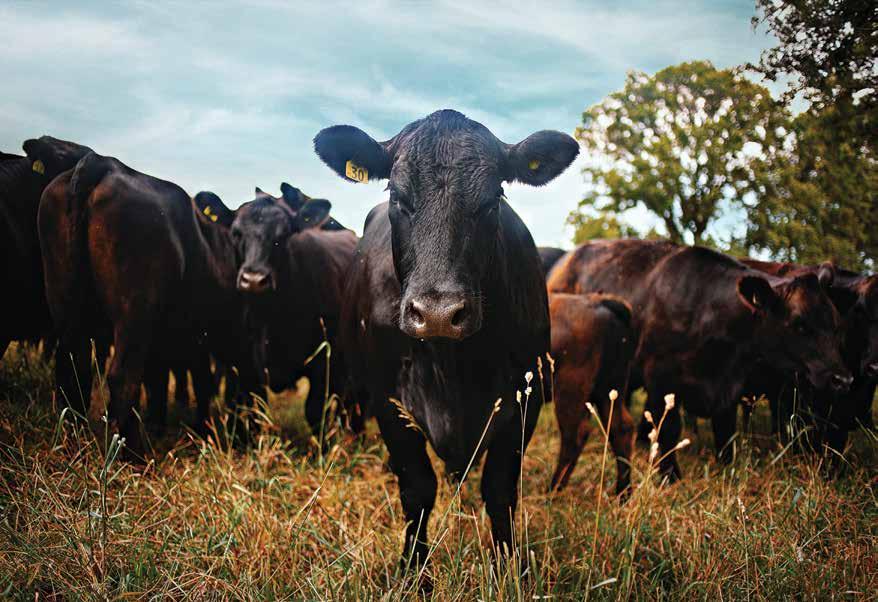
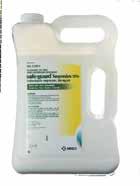


No matter what your operation looks like, consider using Safe-Guard® for the treatment of internal parasitic infections* that could be eating into your bottom line and affecting your herd’s health. Its unique fenbendazole molecule:
• Has been demonstrated to achieve fecal egg count reductions above the 90% efficacy threshold guidelines1,2
• Has been shown to improve pasture performance of cattle infected with internal parasites
– In Western Canadian studies conducted over three consecutive years, increased weight at weaning was demonstrated in calves treated with Safe-Guard® (18.2 lb3, 26.8 lb 4 and 11.6 lb5) compared to non-treated calves
• Is offered in three different formulations (oral suspension, premix or crumbles) for flexible on-farm use
*Please consult the product label for the list of internal parasites that Safe-Guard® is indicated to treat.
Need more information?
• Producers: talk to your veterinarian to determine whether Safe-Guard® is suitable for the animal to be treated
• Veterinarians: please contact your Merck Animal Health representative, call 1-866-683-7838, or go to www.merck-animal-health.ca
Always read the product label for more information on administration instructions and important warnings.
1Are dewormers working? A decade of results. An efficacy summary of the Fecal Egg Count Reduction Test (FECRT) National Database (2009-2018), Merck Animal Health.
2Kaplan, R. M., et al. (2023). World Association for the Advancement of Veterinary Parasitology (WAAVP) guideline for diagnosing anthelmintic resistance using the fecal egg count reduction test in ruminants, horses and swine. Veterinary parasitology, 318, 109936.
3Determination of the benefit of a strategic deworming program for cow/calf operations in western Canada. Study AH75-SAFG-M-2012.
4Determination of the benefit of a strategic deworming program for cow/calf operations in western Canada. Study AH85-SAFG-M-2013
5Determination of the economic benefit of a Strategic Deworming combined with an Anabolic Implant Program for Cow-Calf operations in western Canada. Study 41-AH90-SGRA-M-2014
SAFE-GUARD® is a registered trademark of Intervet International B.V. Used under license. MERCK® is a registered trademark of Merck Sharp & Dohme LLC. Used under license.
© 2024 Merck & Co., Inc., Rahway, NJ, USA and its affiliates. All rights reserved. CA-SFG-240700002
Scan to learn more.
By BFO Staff
In February, the Beef Farmers of Ontario (BFO) hosted their 63rd Annual General Meeting in Toronto, which welcomed close to 400 attendees to the two-day meeting and tradeshow despite some unforeseen weather and airport-related challenges.
To kick off the week, BFO hosted its annual networking reception for the Ontario Beef Youth Alliance where youth member Kaley Rodman was announced as the successful candidate to join BFO’s Research Committee for a two-year term, and who will replace Will Stoneman who completed his term on the Committee. Following the reception, the annual Cattle Academy, sponsored by Zoetis, saw the return of Dr. Bruce Kostelansky who gave a very practical and engaging talk on vaccine handling and administration. To wrap up the evening, attendees heard from the national beef and cattle groups on the value of producer check-off dollars, and how they are used by each organization to support beef farmers in eastern Canada.

In the following days, delegates and guests heard from a number of speakers, including keynote speakers Tim Hudak who shared his five commandments of high impact advocacy, and Dr. Jody Carrington who spoke about the importance of fostering connection and battling burnout. Attendees also heard from a panel, which focused on the topic of traceability and how beef farmers and industry can be prepared for the new Livestock Identification and Traceability Amendments to the Health of Animal Regulations (Part XV) once implemented.
Delegates debated and voted on 20 resolutions, 17 of which were carried. Of significance this year, was a proposed amendment to increase the national portion of the Ontario check-off by $1.50, which was approved with strong support and a vote of 92 per cent in favour of the increase. More on this can be found on page 22.
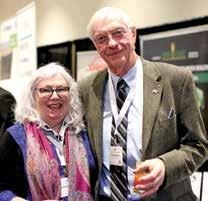
Before the annual banquet, delegates were invited to attend the Past Presidents Reception. Pictured here is Past President Ken Summers (1994) and his wife Sharon.

BFO was pleased to welcome Parliamentary Assistant to the Minister of Agriculture and AgriFood Canada, Francis Drouin, who attended the banquet.
Directors of the 2024 and 2025 BFO Board gathered on stage for a question-and-answer session with delegates.

At the annual evening banquet, BFO was pleased to welcome Parliamentary Assistant to the Minister of Agriculture and Agri-Food Canada, Francis Drouin, who brought greetings and joined the guests for an Ontario Corn Fed Beef dinner sourced from St. Helen’s Meat Packers.
At the same meeting, the BFO Board of Directors elected their 2025 president and vice president. Craig McLaughlin will continue to lead the association in the year ahead as president with Jason Leblond continuing his role as vice president.
Joining the BFO Board of Directors in 2025 are Nicholas (Nick) Martin and Denise Byers for respective three-year terms. Martin, who will represent the feedlot sector on the board and replaced Joe Dickenson who completed two terms, resides on Manitoulin Island where he operates a cow-calf-to-finish operation with his family. Byers will serve as southern director, and replaced Ron Stevenson who also completed two terms. Byers and her family operate a cowcalf-to-finish operation in the Durham Region. Returning to the BFO Board of Directors are cow-calf director Don Badour and at-large director Kim Jo Bliss.
The 2024 BFO Annual Report can be viewed on the BFO website or you can access a hard copy by contacting the office. OB
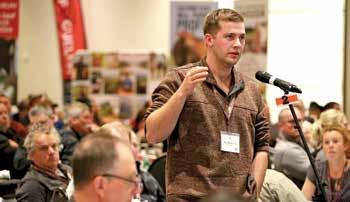


As resolutions are reviewed and responded to by the BFO Board of Directors throughout the year, the responses are posted to the BFO website. Archived responses from previous years are also posted to the website.
25-01 Protection of Livestock from Dogs Act
25-02 Large Animal Vet Access
25-03 PAWS Act
25-04 Yield-Based Insurance Program
25-05 Ontario Wildlife Damage Compensation Program
25-06 CFIA Transparency and Accountability
25-07 Risk Management Program
25-08 RMP Program Guidelines
25-09 Ontario Building Code
25-10 Provincial Abattoir Capacity and Wait Times
25-11 Overweight Carcass Discounts
25-12 Condemnations at Provincial Abattoirs
25-13 Canadian & USA Carcass Weight Differences
25-14 OMAFA Regulation 950 Ticketing
25-15 Crown Land Access
25-16 Breeder Finance Program Enhancement
25-17 Guaranteed First Year Residence at University of Guelph


By Jaclyn Horenberg, BFO Manager of Producer Relations
Ata time when there is so much uncertainty in the beef sector, Beef Farmers of Ontario invited producers to reflect on the basics of beef cattle production in an effort to focus on important management practices that are within their control. We welcomed over 90 producers between the two event locations in Elora on April 5th, and in Selby on April 12th, both of which were also offered virtually. Expert speakers covered broad topics in the areas of nutrition, genetics, herd health, and marketing, which were followed by practical group discussions led by progressive cow-calf producers. Participants were given the opportunity to learn from each other and were introduced to resources available from the Beef Cattle Research Council (BCRC) to help improve their production practices.
Our objectives for the events were to:
• Discuss farm practices required to raise a healthy and uniform calf crop for the marketplace
• Share ideas and learn from other producers
• Explore the resources available to help with decision making
• Learn something that could be implemented on the farm
We began each event with participants introducing themselves to their table group, and then writing down a management or production practice they feel is important to the success of their farm operation. We also provided some


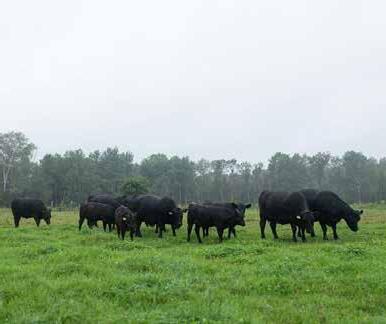
APRIL 5TH - ELORA
APRIL 12TH - SELBY
These in-person events will focus on the basics of cow-calf production that can have a positive impact on reproductive and performance efficiency while improving the marketability of your calf crop.


key highlights of the Ontario data from the BCRC Canadian Cow-Calf Survey results. These survey results highlighted opportunities for improvement in shortening up the breeding season, tightening up the calving window, and improving the ratio of calf weaning weight to cow weight. Reproductive and weaning performance are all intertwined, and they’re all rooted in nutritional, health, and herd management. Paying attention to the basics can help support a producer’s bottom line.
At the event in Elora, we were pleased to host the following guest speakers: Dr. Katie Wood, University of Guelph, “The ABCs of BCS”; Dr. Erin Massender, AgSights, “How to get more bull for your buck”; and Dr. Jacques van Zyl, Metzger Veterinary Services, “Cow-calf herd health optimization”.
After each presentation by our guest speakers, we provided participants with group discussion questions to spark information sharing on practical experiences from their own farm. With Dr. Wood, we discussed body condition scoring (BCS) cattle and nutritional management, with resources being shared on how to properly score cattle, interpreting feed test results, and CowBytes ration balancing software. Dr. Massender got the participants thinking about what traits matter to them when selecting genetics, and encouraging them to use the data available to help make informed decisions. This led to engaging discussions on replacement heifers and culling




We would like to thank all participants from these events for their willingness to share and have open and productive discussions with their peers. This format required participants to be fully engaged in the day, but we hope it also provided opportunities to learn from each other and share practical tips. A special thanks to each of our guest speakers for taking the time to share their knowledge and expertise. We were also appreciative of the funding that we received to host these events through the BCRC Regional Extension Activities Funding program.
To find the BCRC resources mentioned in this article, please subscribe to their blog by visiting www.beefresearch.ca/blog/subscribe. OB

Participants in each session were asked to identify a management or production practice they think is key to success on their farm. Here’s what they had to share:
• Build a team who you can learn from and trust
• Have an open mind and embrace new technologies or new ways of doing things
• Have well structured handling facilities to minimize stress on cattle and the help
• Rotational graze to extend the grazing season and incorporate cover crops
• Keep calving pens or areas clean and dry
• Make genetic selection and culling decisions that fit the environment and management style
• Get calves off to a strong start with an effective calf protocol
• Keep records to make informed management and business decisions
TheBeef Farmers of Ontario (BFO) would like to sincerely congratulate BFO Past President Jack Chaffe and current BFO Director Kim Jo Bliss on their well-deserved and recent acceptance of the prestigious King Charles III Coronation Medal.
To be eligible for the distinguished recognition, an individual must have made a significant contribution to Canada or to a particular province, territory, region or community of Canada, or have made an outstanding achievement abroad that brings credit to Canada. During the anniversary year, 30,000 medals will be awarded, of which 4,000 will recognize members of the Canadian Armed Forces.
In March, Matthew Rae, MPP for Perth-Wellington, presented Chaffe with his medal during an Ontario Cattle Feeders’ Association board meeting in London surrounded by his family, friends, and colleagues.

“Jack continues to be an active community member and staunch proponent of beef farming in Ontario and Canada,” MPP Rae said. “Since he was six years old, he has been heavily involved in advocating for and improving beef farming. From ensuring consumers receive the highest quality beef, to opening more domestic and international trading opportunities, Jack has made a significant contribution to our agricultural community.”
In April, the Hon. Greg Rickford and MPP for Kenora-Rainy River, presented BFO Director Kim Jo Bliss with her medal on her farm
with many of her family members, friends and colleagues in attendance.
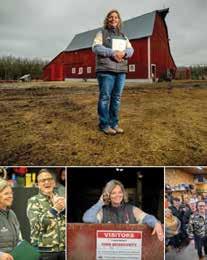
“From the fields of KJB Herefords to the Ontario Crops Research Centre, Kim Jo Bliss leads with purpose — a full-time beef and sheep farmer, research innovator, and mentor to the next generation. Today, she received the King Charles III Coronation for her resounding support for local producers and dedication to the future of farming in the Northwest. Congratulations, Kim Jo,” shared Minister Rickford. OB
The Beef Farmers of Ontario (BFO), DLF and the Ontario Forage Council were pleased to recognize Abbey Taylor of Dawn Farm of Belmont, in Elgin County, as the recipient of the 2025 Ontario Pasture Award. The award was announced in February at the BFO Annual General Meeting Banquet in Toronto. For her environmental improvements and exceptional pasture management, Taylor received a cash award of $500 and a bag of forage seed, courtesy of DLF.
Abbey is a seventh-generation farmer, grazing 15 to 20 heifers on 20 acres of well-managed pasture. She utilizes rotational grazing as her method of improving pasture health, enhancing soil quality and reducing soil erosion, which results in higher productivity for her pastureland and cattle. Her pastures include a range of species including orchard grass, timothy, white clover, alfalfa, Kentucky bluegrass, smooth bromegrass, bird’s-foot trefoil and sweet clover. Abbey purchases her cattle in May to graze until late fall, with daily moves supported by electric fencing and portable water systems. Abbey’s grass-finished beef is processed at a local processing facility and is then marketed direct to consumers.
“The passion that Abbey has for what she’s doing, along with the practices she has incorporated are refreshing and inspiring. She is truly developing a grassroots initiative,” shares Scott Fisher, Sales Manager of Western Ontario with DLF.
Abbey considers herself a steward of the land. She constantly strives to improve her practices to sequester more carbon, reduce emissions, and build soil health. She is happy to share her story and
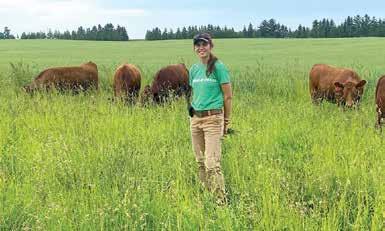
welcomes visitors to Dawn Farm to learn about the multitude of benefits of rotational grazing.
“Abbey is a true example for youth interested in setting out on their own. She manages all aspects of her production from forage management to beef sales with special attention to resilient practices that will assist her in remaining sustainable long into the future,” says Patricia Ellingwood, General Manager of the Ontario Forage Council.
“I want to thank the Ontario Forage Council, DLF and the Beef Farmers of Ontario for honouring me with this award,” says Taylor. “Grazing cattle and feeding my community are passions of mine, and I aim to keep learning and growing my farm business.” OB


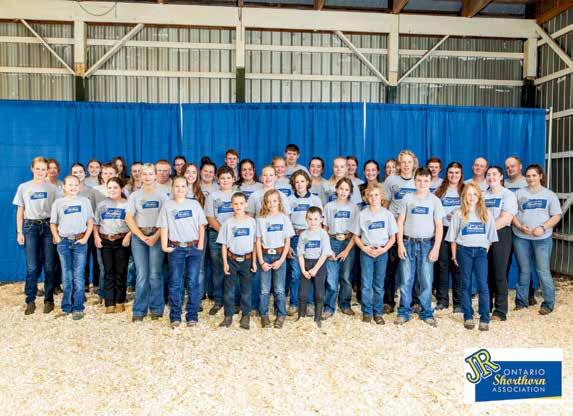









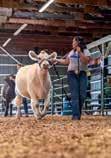


TIBS SHORTHORNS
HOLLAND LANE FARM

Pat Thibodeau Georgetown,ON. 519-319-1901
tibsshorthorns@gmail.com
COLDSTREAM FARM
Flesherton,ON Don Jack-519-924-1540
Shea O’Neill-519-373-6599
Heifer,Bulls,Show Prospects Breed Leading EPDs
Tim&Jocelyn Gilbert&Family Ross Laycock,Herdsman Shannon Kingston,Manager 519-477-1526 hockeymama@live.ca
RED ROSE FARM
Martin&Liz Mason&Sons 747710 Twp Rd 4,Drumbo,ON Cell-519-771-7066 martin.mason@redrosefarm.com
GLENROTHES FARM Beaverton,ON Doug Brown-905-431-8496 Nancy Brown Andison 416-817-0369
LOCUSTVIEW SHORTHORNS
Steve, Joyce & Dan Bartlett Almonte, ON 613-256-3042 locustviewshorts@outlook.com
HILL HAVEN FARM
Duntroon,ON Dale Asser-705-444-9403 Matthew(herdsman)-519-378-5508 hillhavenshorthorns1@gmail.com www.hillhavenshorthorns
MARTIN FARMS Gore Bay,ON Jim-705-348-1294 Nick-705-348-1022 Alex-705-782-4725 Bulls,Females,Commercial Cattle
Steve Barlett, President: 613-256-3042 email: locustviewshorts@outlook.com www.ontarioshorthorns.com
FLIGHTPATH
Caledon,ON David&Joanne Currie& Family David:647-400-2844
Jessica:519-400-3160 farm.flightpath@gmail.com
CRAWFDOWN FARMS Glencoe,ON Gord & Sally Crawford 519-870-7333 Reed & Jane,Shelby&Josie 519-8577333


TheBeef Farmers of Ontario (BFO) was pleased to announce Van Osch Farms as the 2025 Ontario recipients of The Environmental Stewardship Award (TESA), sponsored by the RBC Royal Bank. The award was presented to the family at BFO’s 2025 Annual General Meeting Banquet in February and accepted by Brendon and Kurt Van Osch.
Van Osch Farms, operated by the Van Osch family – Fred, Gerald, Brendon and Kurt – is located in Middlesex County. The farm, with a feedlot capacity of 11,500 head of cattle, is certified with the Canadian Roundtable for Sustainable Beef through the Ontario Corn Fed Beef Quality Assurance Program.

The family is committed to making decisions that improve cattle performance and efficiency, while also improving the land that supports their farm. They’ve upgraded their barn facilities to include natural light and ventilation, and integrated new technologies like recirculating water bowls to eliminate hydro use. They also use solar powered cameras to monitor feed bunks and minimize feed waste. To utilize the upcycling ability of cattle, they also incorporate by-products into their feeding program. Forty per cent of the feed

ration used on Van Osch Farms is made of by-product ingredients, keeping these products out of landfills and reducing food waste.
“Our farm is founded on the core principle that the land is our most precious resource, and that fits well with our certification with the Canadian Roundtable for Sustainable Beef through the Ontario Corn Fed Beef Quality Assurance Program,” says Brendon Van Osch. “We take the sustainability of our farm very seriously and utilize farming practices that ensure the soil and the natural environment are protected for our future generation.”
Van Osch Farms has undertaken a number of projects and land use practices in partnership with Ausable Bayfield Conservation Authority (ABCA) that benefit the watershed and environment. Over the last few years, they have planted over 1,000 trees on their farms. This includes establishing multi-species perimeter shelterbelts at two of their large barns and planting a naturalized buffer around a pond and wetland. Shelter areas have also created homes for many species of wildlife like deer, coyotes, rabbits and birds.
“Van Osch Farms have adopted cover cropping as their standard practice, planting hundreds of acres in cover crops each year,” says Ian Jean, Forestry and Stewardship Specialist, from the Ausable Bayfield Conservation Authority. “Cover crops protect soils from wind and water erosion and improve the water holding capacity of the soil, preventing runoff and sedimentation in our watercourses, improving water quality and aquatic habitat.”
“We know that the most productive land is the land that has something alive on it. This is why we utilize cover crops between our regular cropping seasons to feed our second most important livestock - the critters that call our soil home,” says Brendon.
The Van Osch family will open their on-farm retail store later this month, and they currently offer beef to customers in their community through online sales. Learn more at vanoschfarms.com. OB
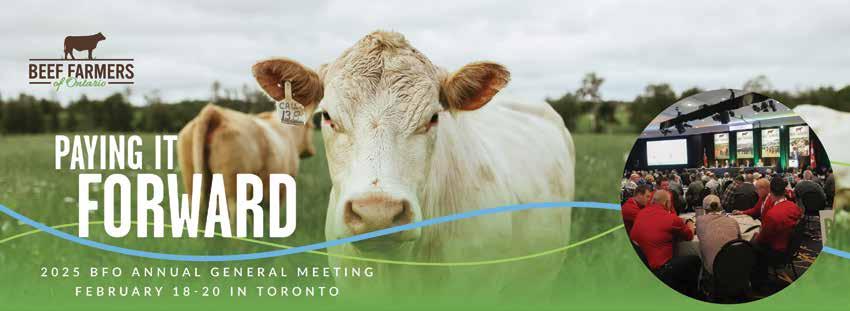
You to our 2025 Annual General Meeting Sponsors















By: BFO Staff
In February, delegates attending the Beef Farmers of Ontario (BFO) 63rd Annual General Meeting in Toronto approved an increase of $1.50 to the national portion of the beef cattle check-off with strong support and a vote of 92 per cent in favour of the increase. BFO has begun the formal process of requesting that the Ontario Ministry of Agriculture, Food and Agribusiness (OMAFA) amend Regulation 54 of the Beef Cattle Marketing Act, which will likely take several months to complete. Upon approval, the existing mandatory $1.00 per head federal agency levy will be increased to $2.50, and total Ontario check-off per head will be increased from $5.50 to $7.00 per head.
The approved increase will provide several important benefits. Firstly, it will help to address financial constraints faced by BFO in light of inflationary pressures and flat marketings. Additional dollars will also be used to increase support for the Ontario Cattle Feeders’ Association for their operations and management of the Ontario Corn Fed Beef program, as well as increased investment in the Ontario Beef Market Development Program which is jointly managed with BFO. From a national perspective, the increase to the national portion of the Ontario check-off will align Ontario’s rate with the rest of the country, and will allow BFO to increase investment in national research and consumer and public engagement efforts to better align Ontario with the National Beef Strategy.

As an association, BFO uses valuable check-off dollars, provided by our membership, to advocate in the areas of sustainability, animal health and care, environment, food safety, and domestic and export market development to help beef farmers, and provide solutions to issues facing the beef sector in Ontario.
The check-off system has a long history in the province, dating back to its first introduction in 1968. Provincial check-off has been collected since that time at various rates, and the mandatory national check-off of one dollar was first implemented in Ontario in 2008.
“We truly appreciate the support of our members and the trust they have put into the leadership of BFO to invest their dollars to make improvements in our sector,” shared Craig McLaughlin, BFO President. “We have a lot of work ahead of us, but we are committed to demonstrating the value we provide to our members through our government relations and advocacy work, our focus on policy and issues, our consumer and market development efforts, and the educational opportunities and support we provide to beef farmers.”
Prior to that, Ontario voluntarily directed funds to the national organizations to support marketing and research.
To give further context, in 2015, the national organizations came together to create unity within the Canadian beef sector and identify key targets to help improve our competitiveness. Out of this, the National Beef Strategy document was created. As part of the Strategy development, it was identified that an increase to the national portion of check-off was needed.
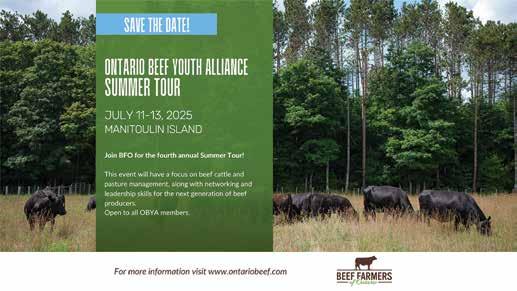
As of 2018, all provinces currently pay two dollars and fifty cents per head in national check-off, and we in Ontario have remained at one dollar for the last 16 years.
As an association, we have always supported the National Beef Strategy, but seven years ago we did not support increasing the national portion of the check-off until a number of issues were resolved. A lot of work has been done by all parties since that time, and positive progress has been made in all areas and our concerns have been addressed.
The new funding will be directed to maintain BFO programming and services, increase support for the
Ontario Cattle Feeders’ Association and the Ontario Beef Market Development Program, and increase investment in national research and building trust and consumer confidence in beef and beef farming.
Unlike other increases in recent years, this check-off increase largely comes down to sustaining our ability to effectively maintain services, capacity and our presence with government and key decision makers, and to help align Ontario with our provincial counterparts and support our national groups who we believe are doing good work.
In addition to the change in the national portion of check-off in Ontario, it also allows the Canadian Beef Check-Off Agency to begin the exploration of adjusting the import levy to two dollars and fifty cents per head or weight equivalent.
Import levy dollars are used for generic beef marketing and the promotion of unbranded beef. Largely used by Canada Beef, these activities focus on keeping beef on the plate of Canadian consumers by promoting the healthfulness of beef, growing consumer culinary skills, and reinforcing food safety practices.
To help support discussions amongst our membership, we created a couple of documents for review. The first is the fourth edition of our Report Card, which highlights many of our accomplishments over the last three years. As well, we compiled a question-and-answer document to help address questions you may have. Both documents can be found on the BFO website at www.ontariobeef.com.
We will keep our membership and industry stakeholders informed on the anticipated implementation of the increase as soon as we have received the necessary approvals from OMAFA. OB
As many know, our ontbeef.ca website includes a store locator feature. This is a Google Map-powered feature that allows visitors to plug in their address and pull up any butcher shop, store, farmers market or farmer selling Ontario beef products within the selected radius of their home. Fortunately, we are seeing a significant increase in people trying to source local products, including Ontario Beef! In addition, we will attend events and have our campaigns in-market throughout the year, so we would really like to continue to build the database of places where folks can purchase Ontario beef products. If you sell beef (or know of someone who does), whether it’s freezer beef, on-farm store, etc., you are more than welcome to be included on the locator map! It is FREE to be added to the map and applying is super easy. Visit ontbeef.ca/store-locator/ to access the simple online form, or contact Jenn at the BFO office. OB








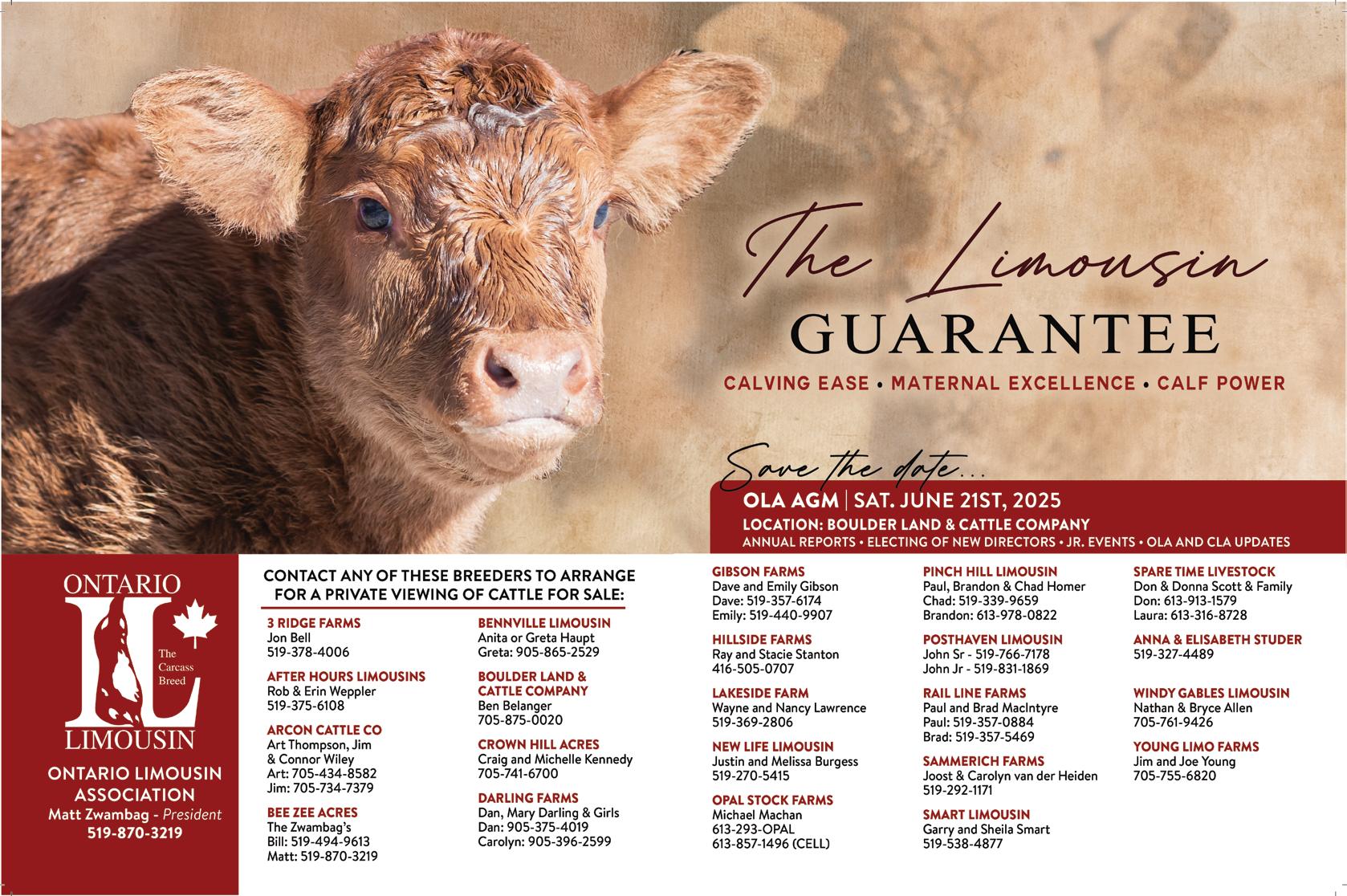


By Lilian Schaer
This past winter, Alltech hosted the first-ever Canadian screening of its documentary A World Without Cows. The film provides an unbiased, global perspective on the relationship between cows and the environment.
According to Livestock Research and Innovation Corporation (LRIC) CEO Kelly Somerville, in a film full of compelling statistics and powerful imagery, one quote stood out: “Farmers are the world’s worst communicators.”
“We hear it all the time—agriculture needs to do a better job of telling its story and this film is one way to push the conversation beyond the usual echo chambers and foster an important dialogue about livestock’s role in our world,” says Somerville.
LRIC, although not directly public facing, plays a critical role in supporting the organizations shaping agriculture’s narrative, ensuring that sound science is available and accessible to inform public discussions about livestock and the environment.
Research that benchmarks environmental performance and highlights the continual improvements by Canadian livestock producers is essential to providing a full and balanced picture, and Somerville notes that Ontario is home to some world-class research on the environmental impacts of livestock as well as cutting-edge facilities at the Agricultural Research and Innovation Ontario (ARIO) research stations.
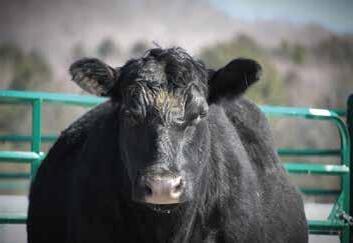
Use BCMPLUS before, during and after calving season to maximize health and reproductive performance. BCMPLUS cow mineral aids in reproduction and fetal development by providing essential nutrients through the pre and post partum and nursing periods. Contact your JFM Beef Sales Consultant to learn more about the advantages of BCMPLUS.
www.jfm.ca • Phone:519-698-2082 / Toll Free:1-800-265-8735
“That’s why I jumped at the chance when I was asked to moderate a panel featuring our members and partners. It was a great opportunity to address an audience of agricultural stakeholders and dive into some of the key points raised by the documentary – from the environmental, social, and economic impact of cattle globally to the ongoing efforts of producers the world over to increase efficiencies,” Somerville adds.
Panelists included Dr. Michael Lohuis, Vice President of Research and Innovation at Semex Alliance; Martha Baker, Global Director Carbon Markets at Alltech; Craig McLaughlin, President of Beef Farmers of Ontario; and Laurie Stanton, dairy farmer and owner of Stanton Dairy near London.
When we’re challenging misconceptions, what do you think is one of the most misunderstood aspects of cattle?
Laurie Stanton: The balance with methane. When you look at the whole picture and how methane is recycled through (nature), we should stress that more. Also, about how important the cow is to society everywhere and how the cow does so much for us.
Craig McLaughlin: We aren’t controlling the narrative. The people telling the story aren’t part of the industry. We are doing good things, and that story is not being told.
Martha Baker: The two thirds of my business card example (Editor’s note: the film showed an example illustrating that the world’s non-usable land made up about 2/3 of a business card; the remaining third is land suitable for growing crops). It’s an easy way to have a conversation about land use and the importance of grazing animals.
Michael Lohuis: What’s misunderstood is the methane isn’t the same as carbon dioxide (CO2). Methane leaves the atmosphere after 10 years, so as long as we keep it constant, we aren’t contributing to warming but CO2 is fundamentally different.
What is the role of breeding and genetic improvement to help mitigate environmental impacts?
Lohuis: It takes many small solutions in the tool box, like methane mitigation supplements in the feed, or genetics. It’s now possible through genomic selection to select for feed efficiency, immunity, and methane reduction. Genetics is a permanent solution and cumulative over generations so over time, it can really help us raise the level of the animals and how sustainable they are.
How do we feed the growing population with farmers asked to do so much more and how do we balance sustainability with this?
McLaughlin: Give farmers a challenge and they will do it. I take pride in being a farmer. Research has improved my farm more than anything, producing more with less and (improving) the survivability of calves.
Baker: I haven’t met a single producer who says they are producing the same as they were when they started farming. We lean on researchers to make us better and our carbon footprint goes down per kilogram of production.
Lohuis: I see the technology that is out there, and I know we will be able to feed 10 billion (people by 2050). It gives me pleasure when I hear someone from Kenya being able to send their kids to medical school because of livestock. If you can produce twice as much meat or milk with same animals, you could reduce the footprint of agriculture and that’s encouraging to me. Going back to the past is not a solution, you can’t solve tomorrow’s problem with yesterday’s tools.
Stanton: I’m looking forward to the challenge. We look at closing our environmental loops, tie in the crop acres and how we manage manure. The nitrogen part of manure still challenges us to get the right answer; there are a lot of little things, and everybody is working on those.
With consumers and government driving initiatives and policies, how can producers stay ahead of the curve?
Baker: Lenders are looking at ESG (environmental, social and governance) policies and that determines the interest rates – are we reaching the goals for 2030 and 2050? The biggest lenders are making claims in the Scope Three emissions of their supply chain which includes farms, yet most farms don’t have a baseline. Organizations use global averages and in North America we are far below those with respect to our carbon footprint, so do a carbon assessment and understand where you are at. With each one do, you can show the progress you are making.
Baker: When we talk about ESG, the movie combines the E and the S really well. The population gets a bit caught in Environmental, but lose sight of the Social, which is the economics.
Lohuis: Upcycling an acre of corn or soybeans through an animal lets you feed 17 people versus three. That’s pretty powerful. (Editor’s note: one acre of corn or soybeans can meet the nutritional needs of three children but the same acre “upcycled” through cattle can meet those same needs in 17 children.)

What were your “a-ha moments” from the documentary?
Stanton: Having people visit our farms is a very good thing. We host quite a few visitors: the city council and the mayor etc. come out and we talk to them about what we do. If you come across as genuine, people will be accepting and will become your advocate.
McLaughlin: The number of byproducts from cows: leather, cosmetics etc. Farm and Food Care Ontario do Breakfast on the Farm to get the urban crowd out. It resonates that message of how people need to see what we’re doing.



Alltech, an LRIC member, is focusing its initial outreach around the film on the agriculture industry and taking requests and proposals for private and industry event screenings. The long-term goal is having the documentary shared on a major streaming service such as Netflix. OB
Livestock Research Innovation Corporation is funded in part by the Sustainable Canadian Agricultural Partnership (Sustainable CAP), a 5-year, federal-provincial-territorial initiative. This article is provided by LRIC as part of its ongoing efforts to report on research, innovation, and issues affecting the Canadian livestock industry.
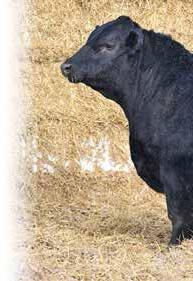
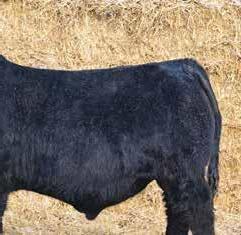

By Tyler Fulton, CCA President www.cattle.ca
Thestart of my term as president is during an odd combination of events. In Canada, a federal election campaign was underway. While this would traditionally be a quieter time for the Canadian Cattle Association (CCA), my calendar quickly filled up with invitations to attend meetings in Washington, D.C. and with key stakeholders in Canada as we continue to try and navigate the uncertainty and confusion about tariffs imposed by the United States.
Canada’s beef sector is heavily reliant on exports, which makes it crucial for CCA to dedicate attention to maintaining market access. That is not an easy task, but there are a couple of silver linings for us. First is that we as beef producers are not in this situation alone. The entire world is impacted and nearly all Canadian industries and businesses are impacted. The second positive element is that we have the National Beef Strategy, developed by the National Beef Advisors, to guide our response. The Strategy helps assure consistent messaging among the entire Canadian beef industry.
There are some in the industry who urge us to pursue other markets that have potential for increased exports. Canada Beef is working hard on this task to ensure that we are prepared for all possible outcomes. Even amongst this tariff uncertainty, the United States is an economic powerhouse that not only takes a large percentage of Canadian beef products, their consumers are willing to pay high prices for beef. I believe that the North American cattle market is complimentary. We are more efficient together from a
global perspective. CCA is committed to continued advocacy on behalf of an integrated North American cattle market, and we hope that it will prevail. When CCA travels to attend meetings in the U.S., we take a message supporting the integrated cattle and beef market. Increased market access around the world can only lead to increased demand for beef, requiring more cattle production and more opportunities for producers.
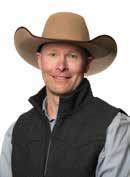
There is no question that tariffs are the main area of focus, but they are by no means the only topic that CCA is working on. Of increased importance following the recent CCA annual general meeting is a renewed focus on animal disease preparedness. It cannot be stressed enough that traceability and biosecurity must be a priority for beef farmers, not just in Canada, but around the world. The ongoing situation with foot and mouth disease in Eastern Europe is of huge concern. Here in Canada, we need a traceability system that works for industry and accounts for our reliance on trade. Our industry takes pride in our commitment to continuous improvement, and it is through that commitment and ongoing consultations between producers and industry that we make these incremental gains to livestock traceability CCA has been involved throughout the process, and we look forward to improvements and simplifications.
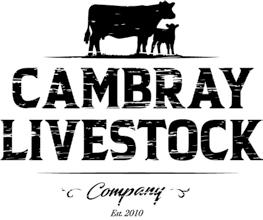
Biosecurity is another topic that needs far more attention than it receives. As a sector, we have some improvements to make, and we simply must be better prepared. The Beef Cattle Research Council and Animal Health Canada recently launched a series of biosecurity resources focused on foot and mouth disease, but these best practices are applicable for preventing all animal diseases. Visit www.beefresearch.ca to learn more.
To reach more producers, I have started recording some short video clips that are being shared on CCA’s Facebook, Twitter/X and LinkedIn accounts. There are so many different types of social media platforms, and we all receive so many emails and text messages every day that it can be very difficult to be heard when you have something to share and to find information that is important to you, especially if you’re not certain when you should be looking for it. I hope that these videos will help CCA’s posts stand out in your social media feeds.
Although our industry is facing a lot of challenges, I am feeling very optimistic about the future. It is important to maintain our focus on young producers. There are great incentives to get into the cattle business, but we need to provide tools for new and young producers to manage the risk that is required to invest in land and cattle. CCA will continue to pursue these needs with the new federal government OB


By Gina Teel, Director, Stakeholder Communications, Canada Beef
Canada Beef recently activated stepped-up strategies to maintain loyalty to Canadian beef in the domestic market and expand the presence of Canadian beef in high opportunity international markets - many of which were impacted by reciprocal tariffs unleashed by the United States (U.S.) administration in April.
Here at home, consumer campaigns put the spotlight on value and pricing with resources such as Make the Most of Beef, a booklet that informs consumers how to buy bulk cuts and cut it themselves to save and tips to stretch the beef budget even further by utilizing value cuts. The Graded for Greatness campaign builds awareness about Canada’s quality grades and selecting the right grade for a particular dish/type of cooking for positive outcomes.
The value of buying Canadian beef and tips to identify it at the meat counter were strong campaign themes that coincided with the ‘buy Canadian’ trend as Canadians showed their national pride in response to the U.S. tariff situation. Taglines like the ‘Pick the Beef with the Leaf,’ and information from Canadian Beef Advantage (CBA) resources helped demonstrate the value of buying Canadian beef.
A recent campaign in Toronto, a major urban target market for Canada Beef, encouraged consumers to ‘Pick the Beef with the Leaf’ via a high visibility, Canadian Beef wrap on the exterior of a Toronto Transit Commission city bus. Additional signage inside the bus encouraged riders to post a selfie with the bus and enter a contest. The bus took different routes through Toronto streets each day of the campaign period to maximize exposure to the messaging. The bus and its travels were promoted on Canada Beef’s social media channels.
The third annual Burger It Forward (BIF) campaign (February 1-28, 2025) posted great results. The campaign saw a record 262 participating restaurants – that’s a 30 per cent increase - and 5 per cent more burgers sold compared to 2024 and raised an estimated $61,339 for food bank efforts across the country.
This Canada Beef giveback campaign aimed to raise funds to support food security efforts nationally across nine provinces. The goals supported foodservice recovery at the local level while promoting the local beef supply.
Media outreach for BIF 2025 saw massive uptake. The campaign achieved a reach of 21 million through paid, earned, owned and shared media, with earned media being the largest contributor. This is up from a reach of 2.7 million achieved in 2024.
On the channel side, core modules for the Certified Canadian Beef Training Program’s (CCBTP) Retail and Foodservice programs are complete and being put on the Brain Shark learning platform. The digital training platform is free for industry and students in retail and foodservice channels, offering practical and accessible Canadian beef training.

Canada’s cattle industry was spared from the U.S. administration’s reciprocal tariffs on April 2 due to a carve out for products that are Canada-U.S.-Mexico Agreement (CUSMA) compliant such as Canadian live cattle and beef. The reprieve continued for CUSMA compliant goods the following week when the U.S. administration implemented and then paused some of its substantial new tariffs for 90-days.
With no guarantee of a return to normal trade relations anytime soon and headwinds including the renegotiation of CUSMA in 2026, Canada Beef is actively exploring alternative export markets with potential for further expansion and diversification of Canadian beef exports.

















Market diversification is why Canada Beef travelled to the United Arab Emirates, Mexico, Japan, South Korea, Vietnam, Taiwan and the Philippines this spring.
From April to October, Canada Beef plans to exhibit at the Seoul Food Show in South Korea, Food and Hospitality Indonesia, WOFEX in the Philippines, ANUGA in Germany as well as a demand building seminar in Japan. Additional demand building seminars in Canada Beef’s key emerging Asian markets are in the process of development for later in the year.
Canada Beef’s Investment Plan for the 2025–2026 fiscal year (effective April 1) represents an upshift in strategies to maximize opportunities for Canadian beef and broaden consumer loyalty through the continuation of a tight market scenario and sustained pressure on the retail price environment.
With robust demand for beef and a tight supply forecast expected to continue, the strategies in the investment plan will help Canada Beef deliver on its mission to create value for producers and the entire beef value chain through impactful and innovative marketing solutions to enhance demand, experience, and awareness.
Initiatives to promote the value of beef as a protein and nutrition powerhouse as well as its versatility in terms of ability to satisfy a range of budgets and preferences, will cultivate brand awareness among key target audiences including women, seniors and immigrant and new Canadian communities.
The Canadian Beef Marketing Alliance Program is a new initiative to support projects that expand the reach of messaging for Canadian consumers in priority areas. This innovative cost-shared initiative (50-50 projects) is open to industry partners that meet the program requirements for collaboration on projects with Canada Beef to promote Canadian beef.
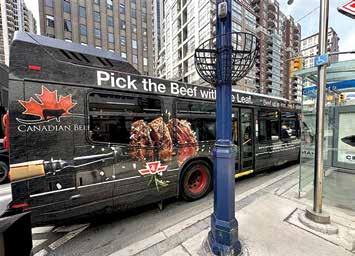
Canada Beef amalgamated both of its X accounts to @ CanadaBeefInc, tooled specifically for a beef producer and industry stakeholder audience. Additionally, oversight of @CanadaBeefInc and the producer Facebook channel @CanadaBeefInc was transitioned to Canada Beef’s Stakeholder Communications department.
Content for @CanadaBeefInc will focus on pertinent information for stakeholders and timely updates on activities underway at Canada Beef. Be sure to follow us on the producer handle @CanadaBeefInc on X and Facebook and subscribe to Canada Beef Performs.
Finally, Canada Beef would like to acknowledge the contribution of Joyce Parslow, who retired in April after two-and-a-half decades with the team. Joyce’s passion for food and agriculture made her an exemplary advocate for Canadian beef producers. Her creativity, energy, and excellence will be missed. OB
Canadianpride and the conscious effort to purchase local goods and services by citizens and business owners has been mounting as the country navigates tensions with its U.S. neighbours. BFO can confirm the sentiment, as interest in its web-based Ontario Beef product locator has experienced an uptick in usage by consumers over the last several months, and in butcher shops and farmers who direct market beef wanting to be included in the Google Maps-driven locator and advertising tool.
Pride in Canada’s beef sector is also being expressed in other ways through the support of local business owners.
Bob Lowe, a longtime business owner of Dalton R. Lowe and Sons in Stayner, Ontario, a gravel crushing and trucking company recently unveiled two custom-painted gravel hoppers, each bursting with Canadian pride.
One hopper features a black silhouette of Terry Fox, and the other, a beef animal in support of the “Buy Canadian” movement.
Lowe has a personal connection to the agriculture sector, his brother-in-law, Jim Whitley, is a director with BFO and a board member with the Canadian Cattle Association.
What makes this story unique is that Lowe has been blind since 2016. He lost his left eye to cancer in 2007, and his right eye in a construction accident just nine years later. Lowe is completely blind in both eyes.
Despite this obstacle, Lowe continues to run his family business with his wife Tammy, and remains very active by playing blind hockey and biking with his sister in his free time.
The red and white imagery on each truck isn’t something he can physically see each day, but these special silhouettes are engraved in his mind from before his accident.
“I can still picture the Canadian flag and Terry Fox in my head,” Lowe explained. “They’re strong, clear silhouettes that I remember from before I lost my sight. That’s why I chose them.”
“I wanted to show my pride in Canada, in our farmers, and in who we are,” he continued. OB


By Beef Cattle Research Council
beef cattle producers retain females from within their own herd or purchase them, replacement heifers come at a cost and are an investment into the future herd. Selecting the right animals and proper management is necessary to meet on-farm goals and improve the longevity of heifers as future breeding cows.
A recent analysis of 63 farms across Canada enrolled in the Canadian Cow-Calf Cost of Production Network estimated the cost of raising replacement heifers in 2023 to be an average of $2,904 per heifer, with a range of $1,905 to $3,806, which is estimated to be even higher in 2025. The largest expense of raising replacements being the lost opportunity of selling the heifer. Depending on cost of production, producers could pay back their investment in replacement heifers in five to seven years.
From a whole-herd perspective, total replacement cost depends on both the cost of raising each replacement heifer and the overall replacement rate. For the 63 benchmark farms, replacement cost accounted for an average of 8 per cent of total herd costs in 2023. When the cost of all replacement heifers is distributed across the entire cow herd, the average replacement cost per cow is estimated at $139, with a range from $50 to $272 per cow.
To reduce these costs, producers can focus on management strategies including improved cow longevity. The more calves a female can produce in her lifetime, the better the return on her investment.
Copper-T Ranch is a Hereford seedstock operation located in north central British Columbia on the north shore of Fraser Lake that annually breeds approximately 100 females for April calving. The herd was established in 1988 by Trevor and Janice Tapp. Jamie and Bill Lloyd were hired onto the ranch ten years ago as cattle managers and are now also co-owners.
The purpose of the operation is to breed replacement genetics for themselves and other herds that will carry forward as a predictable and stable herd foundation. For breeding, they use both natural breeding and reproductive technologies, including artificial insemination (AI).
“The use of AI allows us to bring in outcross and progressive
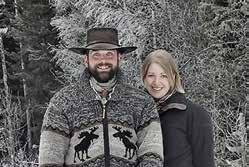
genetics,” the Lloyds say. “We are very selective with our AI sires, as well as our walking bulls - not seeking the next top show bull or genetic trend, but rather selecting for predictability, structure, performance and longevity.”
When it comes to herd sire selection, “being able to view photos of the dam and related females, as well as dam performance records, feet and udder structure before committing to a new herd sire is a must for us. The females behind our sires must be rock solid, and the type you want to have a whole herd of,” the Lloyds added.
For selecting replacement heifers there are a few traits that the Lloyds are looking for:
Feet: “If you have a herd with excellent feet, you want to keep that, it can quickly be lost.”
Disposition: “Easy to handle females are a must, calving is not meant to be a contact sport.”
Instinct/ Maternal Vigor: “…in both the female and the calf. If a firstcalf heifer has a textbook birth, but does not lick her calf off, write it down and cull her. That is not the type of female you want to be keeping and creating more of.”
Growth and Production Performance: “Replacement females selected must meet our guidelines, we implement a weaning weight and yearling weight cut-off. They must be at a desirable weight at breeding season and meet a frame size criterion; either extreme is undesirable.”
Calf Performance: “A first-calf heifer must go forward and wean a calf above our minimum expectation, proving she milks well enough and does so while keeping her condition and breeding back in a timely manner.”
The Lloyds say heifers are bred to calve 10 to 14 days ahead of the main cow herd to increase the probability for breeding back in the first cycle as young cows.
Record-keeping is also part of the selection process, according to the Lloyds. “We record dam udder and feet score, weaning weights, yearling weights, average daily gain (ADG), frame score and service date. We avoid retaining heifers that are bred late (third cycle) as we find the probability of them having breeding longevity is low.”
The Lloyds use records to evaluate cow or sire family genetic trends, which impact longevity. For example, daughters of a certain sire that are coming in open, or certain cow families whose daughters eventually come in open.
“Once you find these patterns they can be quite predictable. Find genetic lines that work well in your environment,” the Lloyds say.
Optimal nutrition is key when feeding replacement heifers to ensure they are ready to turn out to breed at a proper weight and overall health. The Lloyds also stress the importance of not overfeeding since this can negatively impact fertility. “Other than being preg-checked in the fall, her place as a mother cow starts here, and she must maintain her condition on a cost-effective feed program in our mature cow herd.”
Copper-T Ranch in British Columbia and Dudgeon Cattle Company in Ontario illustrate best practices in replacement heifer selection and management. Copper-T Ranch prioritizes structural soundness, maternal traits and record-keeping to ensure predictable, long-term herd performance. Dudgeon Cattle Company emphasizes temperament, growth and durability, incorporating rigorous health protocols and a structured breeding program to maintain quality in their annual heifer sale. Both operations use data-driven selection processes to maintain herd efficiency and profitability.
ones that are getting away from you we pull out; anything that is nervous is pulled from the sale pen.”
To make the sale catalogue, the replacement heifers must have the required traits, “thickness in the butt end, performance and milk,” the Dudgeons say, adding that they “don’t chase fads and keep the commercial guy in mind so everyone can make a profit at the end of the day.”
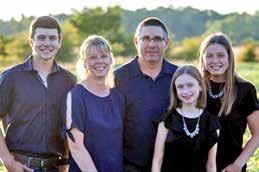
Brian Dudgeon and his family own and operate Dudgeon Cattle Company in Dobbinton, Ontario, just north of Lake Huron. Each year the family produces “The Top Cut” heifer sale, the largest bred heifer sale in Ontario, selling over 200 head. They currently have a 200-cow herd with 50 of these being purebred Black Angus cows. Their top heifer calves are entered into their sale program. The remaining calves are backgrounded and finished in their feedlot. They also purchase 300400 heifers in Alberta and Saskatchewan to raise using their replacement heifer protocols with the intent to fill the sale catalogue.
Within their own herd, the Dudgeons value “longevity, practicality, durability, above-average growth at weaning age, thickness, temperament, structure, proportion, feminine, carcass weight, raise big calves for the feedlot, good frames and length.”
When selecting bulls for breeding to replacement heifers, they aim for expected birth weights in the 60-80-pound range while also placing high value on temperament. “We work with these animals a lot, so the

They also rely on record-keeping to assist with selections.
“If a heifer has been pulled due to a health treatment, depending on what the health issue was, the heifer may not have the longevity we’re aiming for, or she may not breed. If that is the case, she doesn’t go into the sale.”
Prior to breeding, the heifers are fed a Total Mixed Ration (TMR).
“We feed a balanced TMR that is slightly higher in energy than a backgrounding ration. The goal is to get the heifers to 900 pounds or better when they’re bred.”
To help keep heifers organized for the sale, the Dudgeons use a coloured ear tag system.
Effective replacement heifer management requires a balance of careful selection, record-keeping and proper nutrition. By focusing on structural integrity, temperament, maternal instincts and overall performance, producers can improve herd longevity and financial returns. For producers looking to enhance their replacement programs, a focus on genetics, herd health and strategic culling can make a lasting impact on their investment. OB
The Beef Cattle Research Council (BCRC) is Canada’s national industry-led funding agency for beef, cattle and forage research. The BCRC’s mandate is to determine research and development priorities for the Canadian beef cattle industry and to administer Canadian Beef Cattle Check-Off funds allocated to research. Visit www.BeefResearch.ca to learn more.









“The biggest challenge was finding the courage to share the everyday moments of life on a working farm— especially the parts that people outside of agriculture rarely see,” said Charlotte Wasylik, a young beef farmer from Alberta, speaking to the audience at Farm & Food Care Ontario’s (FFCO) Annual Speakers’ Conference in Elora on April 10. “But once I did, I discovered how powerful regular storytelling can be.”
Charlotte’s willingness to share both the rewarding and the real sides of farm life has helped grow a loyal and engaged consumer following. From early morning chores and hands-on animal care to jampacked delivery runs, her storytelling builds trust and fosters meaningful connections with audiences eager to understand where their food comes from.

Introduced by fellow beef farmer and Beef Farmers of Ontario director Joost van der Heiden, Charlotte joined the conference as one of its featured speakers. Her message? Transparency builds trust, and farmers need to bring people along for the whole journey.
Charlotte grew up on her family’s farm, Chatsworth Farm, near Vermilion, Alberta, raising commercial cattle, sheep, poultry, legumes, and cereals. She works alongside her parents Rick and Joanna, two siblings Nick and Alex and fiancé Rob. Most of the family’s 220head commercial beef herd are sold through the Verified Beef Production Plus (VBP+) program. However, the family continues to increase their direct-to-consumer sales through their farm-totable program.
Charlotte uses social media as a platform to share her love of farming and to market their farm-to-table products. On Instagram and Facebook, she offers behind-the-scenes glimpses of daily life that includes showcasing the animals, butcher visits, order prep, and how they cook with what they grow and raise. Charlotte’s family also opens their farm gates to host pop-up farm shops and makes monthly trips to Edmonton and bimonthly trips to Calgary to deliver beef, lamb, pork and eggs to customers.

“People have questions about what their livestock eats, grass-fed versus grain fed, the medication and vaccines used and even how the animals are butchered,” she explained. “In my experience, people aren’t as critical of farming practices as we think—they’re just curious.”
Charlotte shared that early in her social media journey, she lacked the confidence to post the kind of content she does now. But over time, she saw how followers responded most to real, unfiltered content. They didn’t want perfection— they wanted honesty, and a safe place to direct their “this might be silly to ask, but…” questions.
Charlotte has made it her mandate to show the entire process from birth to the butcher and even how to cook their meats. “Some days our account might feature updates about a tough calving in the morning and a trip to the butcher that afternoon”. Her followers get to see the ups and downs of raising livestock on their family farm. Not everyone was initially on board. Her brothers were hesitant, worried that sharing a sick animal or a tractor stuck in the mud could hurt business. But the opposite happened. As Charlotte continued to share their farm’s behindthe-scenes moments, the results spoke for themselves. They saw a positive impact not only on their Instagram page but also on their meat sales. Eventually, her brothers began texting her photos of their own stuck-tractor moments— proof they’d come around to the power of sharing.
While Charlotte doesn’t post every animal health issue or equipment breakdown, she believes in showing consumers that not everything is in a farmer’s control—and just how much care and effort go into looking after livestock. She shared examples of heartwarming responses from followers after she documented a months-long journey rehabilitating a breeding ewe. Each message thanked or commended her for sharing the real, hard parts of farm life.
At the conference, Charlotte emphasized that building trust with the public starts by “sharing every step” of the farm-to-fork journey. She spoke candidly about the feedback she’s received from customers and followers who are actively looking for farms that are transparent about how their food is raised.
Of all her online interactions, she says less than one per cent are negative. The overwhelming majority are positive, curious, and supportive. Her account serves as not only a marketing tool for their farm but also a place for consumers to learn, ask questions, and connect with other like-minded farms across the country.
If you’d like to follow Charlotte’s journey and learn more about Chatsworth Farm, you can find her on Instagram and Facebook at ChatsworthFarm. OB

Because of their balanced profile of calving ease, growth and carcass quality, Canadian Angus cattle work well in both purebred and commercial operations. Use Angus bulls to make top performing feedlot steers and beautiful replacement females.
Visit the Ontario Angus Association website for more information: www.cdnangus.ca/ontario-angus-association

Contact any of the breeders below to arrange for your private viewing of cattle for sale.
Cairnlee Acres
Victor, Yvonne & Andrew Richardson 6193 Walkers Dr, Strathroy, ON Vic Cell: (519) 871-4240
Cambray Livestock Company
Luke, Matt, Joe and Carl Jewell 1153 The Glen Road, Woodville ON 705-934-2853
Fallis Land and Cattle
Mike, Lisa and Cole Fallis 1273 6th Line, Selwyn, ON K9J 6X5 705-740-4878 | sunsetacres@nexicom.net
Gilchrist Farms
Brad & Kristie Gilchrist
1269 Grey Ox Ave RR#5 Lucknow, ON N0G 2H0 519-440-6720 | brad@gilchristfarms.com
Glen Islay Angus
Don Currie
2234 Conc 11, Nottawa, ON L0M1P0 705-715-2234 | doncurrie@glenislay.com
Loval Farms
Scott & Sandra Honey 127 Honey Road, Warkworth, ON K0K 3K0 705-924-3809 | lovalfarms@gmail.com
Harprey Farms
Allan Hargrave/Don Hargrave 307483 Centre Line A Proton Station, ON N0C 1L0 Allan 519-375-5541 | Don 519-375-1500 harprey@gmail.com
Maple Line Farm
Ian & Tim Rudkin 3320 Bradburn Road, Blackstock, On L0B 1B0 Ian 905-718-5331 | Tim 905-213-6518 maplelinefarm@hotmail.com
Meadow Bridge Angus JJ Deslippe 922580 Rd 92 RR # 4, St Mary’s, ON N4X 1C7 519-275-1739 | deslippe@quadro.net
Rob Roy Angus
Don & Betty McNalty 634514 Road 63 RR#2
Singhampton, ON N0C 1M0 705-446-4740 | robroyangus@gmail.com
SCOMAC Livestock
Scott & Elizabeth MacDonald 4169 Highway # 6
Hagersville, ON N0A 1H0 Scott 519-820-1272 | Elizabeth 226-971-0015 scomaclivestock@gmail.com
Silver Springs Farm
James, Joan, Robert and Emily McKinlay 609027 12th Sideroad RR#1 Ravenna, ON N0H 2E0 519-599-6236 | jmckinlay@bmts.com
Tullamore Farms
Bill & Sylvia Jackson 260 Regional RD 39 Zephyr, ON L0E 1T0 Cell 647-990-2697 tullamore.angus@gmail.com
Whiskey Lane Livestock
Scott, Paula, Jason & Shelby Cornish 2295 Hwy 7, Indian River, ON K0L 2B0 705-341-3220 | wll@nexicom.net
Windcroft Farms
Darcy & Courtney McMorris 573333 Boot Jack Ranch Road
Priceville, ON N0C 1K0 226-203-4506 | windcroftfarms@gmail.com
Worth-Mor Cattle
Kyle, Rachel, Jordyn and Mason Petherick 950 County Rd 8 Campbellford, ON K0L 1L0 705-768-3560 | worth-mor@hotmail.com
It is no surprise that Canada’s beef sector continues to focus on the engagement of young entrants into the beef industry, whether that be grassroots producers, future leaders of our national and provincial organizations, or industry partners along the value chain.

The Canadian Beef Check-Off Agency (the Agency) continues to diversify its youth strategy with the renewal of the annual scholarship, aimed at students who intend to make an impact in Canada’s beef sector.
The scholarship is open not only to beef producers and those directly involved with their families, but it is open to students who can see unique ways to make an impact through marketing, research, public engagement, and other areas where check-off dollars are invested to generate value for the beef industry in Canada.
“We are working hard to ensure that we are engaging the next generation of industry leaders,” said Trevor Welch, Agency Chair. “This scholarship allows us to reach pockets of young producers that we often find it challenging to connect with.”
Adeleen Bolduc, the Agency’s Youth Member and member of the scholarship committee, sees value in the extensive range of career paths that can help shape Canada’s beef industry.
“Our scholarship outreach is one of the most successful communications programs to date at the Agency,” said Bolduc. “We have been focusing on different platforms to get the word out to young beef industry stakeholders and it has been extremely positive.”
While preference may be given to applicants who are beef producers or have a background in agriculture, it is not a requirement for the scholarship.
Applicants are asked to submit a one-to-two-minute video, showcasing their desire to improve and grow Canada’s beef industry in a unique way. The investment of the beef check-off in Canada delivers value to the beef industry, and the scholarship seeks to support those who want to make an impact in the same way.
The deadline for scholarship applications is June 30, 2025 and the selected applicant will be announced during the Agency’s AGM on August 19, which will be held virtually. Apply by visiting cdnbeefcheckoff.ca/scholarship. OB

Auction Market
D.H. Hickson Limited, Campbellford, ON
Now
Abattoir
2573508 Ontario Inc., Pakenham, ON Montpak International Inc. o/a Viandes Forget Ltee, Laval, QC
Auction Market
1001065062 Ontario Inc o/a Hoards Station Sale Barn, Brussels, ON
Country Dealer
1267388 Ontario Incorporated o/a Gingerich Veal Transport, Harriston, ON
Allan Stirling and Marilyn Stirling, Little Britain, ON Brandon Taylor, Warkworth, ON
The Ontario Beef Cattle Financial Protection Program is administered by Agricorp. The listing of licensed dealers is updated regularly and the complete listing can be found on the Agricorp website.

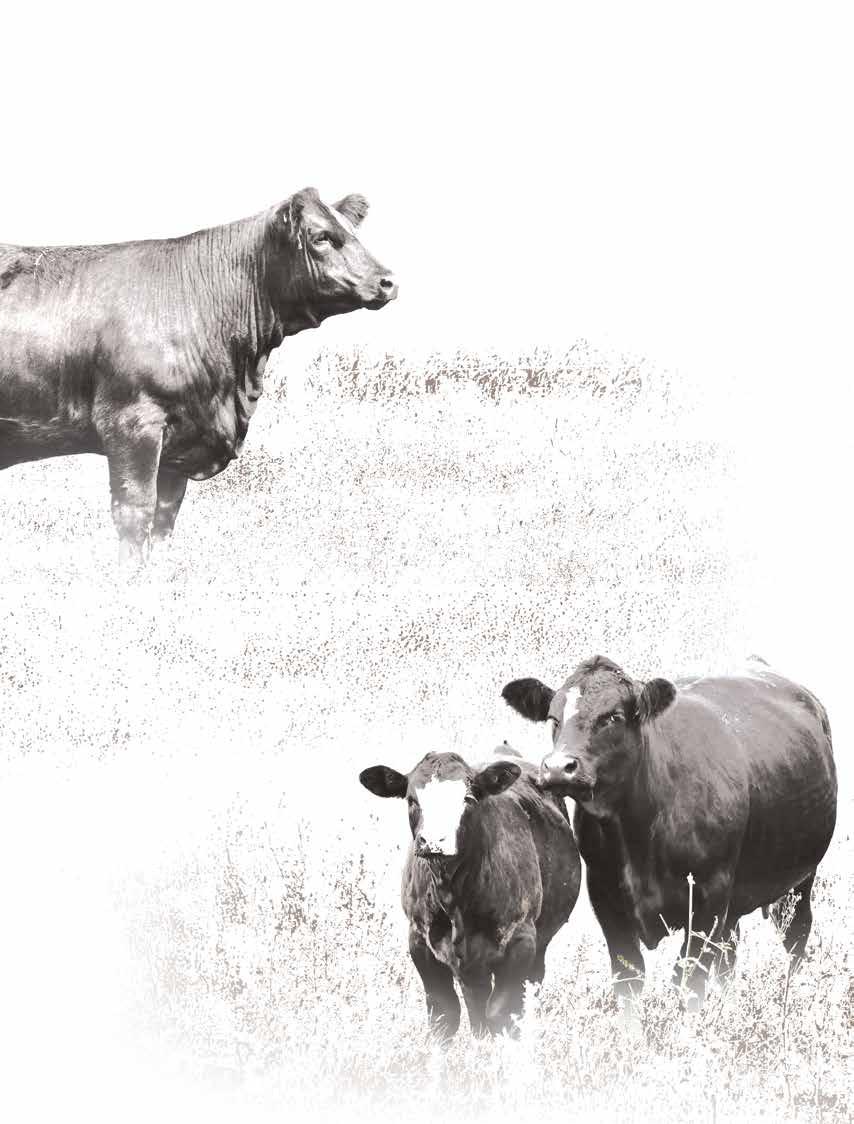
EXECUTIVE:
DIRECTORS:
Jeffrey Holland
Scott Dykstra
Patrick Leahy
Suzanne Bovey Reed Crawford Mike Thomas Nick Ashby Dwayne Horst
Stewart
Dwayann Simmentals
Canadian
Bovey
Simmgen
Amanda
Tullamore
Earley Livestock
Dufferin Veterinary Services
Brandlee Simmentals
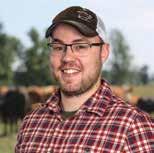
By Daniel Pecoskie, DVM, Metzger Veterinary Services
cattle head to pasture for the summer, it’s important to take proactive steps to reduce the risk of disease. Vaccinations, deworming and fly control can help keep your herd healthy and productive. However, even with the best prevention plans, some calves and cows will still require treatment, and doing so on pasture can pose some unique challenges.
Before we can treat cattle successfully, we must first identify cattle that are sick and require treatment. Accurate diagnosis is essential to selecting the right medication and ensuring treatment success. Treatment failure is often a result of misdiagnosis or incorrect use of antibiotics, including using the wrong drug, dosage or route of administration.
Pneumonia Increased respiratory rate, puffing
Dull, depressed
Temperature ≥ 103.5°F (39.7°C)
Pinkeye Squinting, excessive tearing
White spot in the centre of the eye
Scours/Diarrhea Loose manure, sometimes with blood
Dehydration, sunken eyes
Dull, depressed, weak
Lameness Non-weight-bearing or toe-touching
Foot rot:
• Swelling at ankle, toes spreading apart
• Broken skin between toes
Laceration
• Cut skin, skin flap, bleeding
Sprain/Injury
• Swelling possible, but there may be no apparent lesions
Lesion in the hoof
• Toe abscess, cracked hoof, foreign body, sole bruise, etc.
Lameness can be attributed to many different causes. A working diagnosis can be made by assessing the nature of the lameness, which will help direct our treatment. A sprain, toe abscess or foot rot may all appear similar at first glance but require very different treatments. Examining the affected leg for swelling, symmetry or visible lesions from a distance can help narrow down the diagnosis. In more subtle cases of lameness, restraint may be necessary to pick up the hoof and trim the sole and/or toes.
Depending on where the cattle are pastured, there are many options to segregate and treat sick cattle.
Options include:
Permanent or mobile corrals and fences: Useful for sorting and treating individuals or groups, especially with a portable chute.
Transport to a home facility: Corrals can also be used to collect cattle to transport back to a home farm location with a permanent cattle handling facility.
On-pasture treatment: Ideal for isolated cases, especially for diseases like pinkeye or pneumonia, where crowding can worsen spread
If no facilities are present on pasture, options for restraint of sick calves for exam and treatment include roping or catching with an ATV or side-by-side. Very sick cattle may not move away very quickly and can be approached while lying down. Down calves and cattle may require further veterinary exams and treatment. In all cases, safety and animal welfare should guide the approach.
If the producer can confidently identify a condition, such as pinkeye, pneumonia or foot rot, there are options to quickly administer antibiotic treatment from a distance, under veterinary guidance. Dart guns, which use compressed CO2, allow for quick delivery of antibiotics directly into sick cattle without the need for close handling. Darts need to be administered into the neck muscles and shot perpendicular into the neck (standing directly to the side of the animal). By working with your veterinarian, choose the appropriate dart size and needle length based on the drug being used and whether it requires intramuscular (in the muscle) or subcutaneous (under the skin) administration. Darts are not reusable, and a fresh dart should be used each time. Alternatively, a pole syringe (or jab stick) is another method to quickly administer certain medications into the muscles of the neck.
Group treatments or prevention, such as fly control, can be administered directly on pasture. Cattle oilers or seasonal deworming/pour-on products can help control fly populations and the spread of pinkeye in mid-to-late summer. Certain diseases can also be prevented or treated through medication in mineral supplements, water troughs and supplemental pelleted feeds or grain mixes.
Continued on page 44.

By Jamie Kerr, Market Analyst for Canfax and BFO markets@ontariobeef.com • www.ontariobeef.com
President Trump made tariffs a staple of his presidential run, and has since threatened, delayed, imposed, and lifted tariffs on Canadian products entering the U.S. This has destabilized markets on both sides of the border. With the imposition of tariffs over three days during the first week of March, Ontario feeder cattle prices were down 2% from the last week of February and cull cows were down 8-10%. On April 2nd, President Trump imposed sweeping tariffs against nearly all U.S. trading partners, however, Canada and Mexico were spared additional levies. By April 9th, tariffs against most countries were reduced to 10%, though the trade war with China continued to escalate. Uncertainty will remain high, until all tariff threats are addressed and removed.
Total Canadian cattle and calves on January 1st, 2025, were 0.7% smaller at 10.9 million head and are the smallest since 1988. Despite a strong price signal to stabilize or expand the herd, continued weather concerns, especially in the west, along with succession on the farm and competition for land are some of the external factors delaying that from occurring yet. Canadian beef cow inventories were 3.38 million head, down 1.2% (-40,800 head) from last year and are the smallest since 1989. Beef heifers retained for breeding were 520,700 head, up 0.8% (+4,100 head) but was insufficient to stabilize beef cow numbers.
In Ontario, total cattle on January 1, 2025, was fully steady with 2024 at 1.55 million head. The cow herd is showing signs of moving into expansion with beef cows up 1.1% and beef replacement heifers up 6.5%. The Ontario beef cow herd is the second smallest on record going back to 1976 behind 2024. Fed cattle volumes were down 1.4% (-5,400 head) from last year. Fed steers have been largely stable near 260,000 head since 2015. Calves were down 0.5%. The dairy cow herd was 1% larger than 2024 with replacement dairy heifers up 0.5%.
Fed steers averaged $274/cwt in the first quarter of 2025, up 17% from the first quarter of 2024 and 46% above the five-year average. On a dressed basis, fed steers averaged just shy of $455/cwt in the first quarter. Steer prices had been putting in incremental gains every month between October 2024 and February 2025. However, March

brought significant uncertainty to the market as U.S. tariffs on Canadian products (including live cattle) became a reality for two days. Fed steer prices eased $17/cwt lower from February to March 2025.
A strong lean trim market in the first quarter of 2025 pulled cull cow prices higher. Ontario D2 cows averaged $169/cwt, up 24% from last year and 78% stronger than the five-year average. In the first quarter of 2025, D2 cows were priced at 62% of a fed steer, compared to the first quarter of 2024, when D2 cows were at 58% of a fed steer with the five-year average at 52%. The Ontario cull cow market was at a discount to both Alberta D2 cows and U.S. Utility cows in the first quarter.
Feeder cattle continued to have strong fundamentals in the first quarter. Steers and heifers 600 lb and over moved 6-10% higher between the fourth quarter of 2024 and the first quarter of 2025. Steers and heifers under 600 lb were mixed ranging from a small 1% decline to a 4% increase. Ontario steer calves were at a $66/cwt discount against their Alberta counterparts in the first quarter of 2025 and a $46/cwt discount against same-weight U.S. calves. Heavy Ontario feeders mirrored their lighter-weight counterparts, with Ontario 850-lb steers at a $9/cwt discount to Alberta and a $6/cwt discount to the U.S.
Ontario processing volumes in the first quarter were 132,000 head, steady with 2024 and down 11% from to the five-year average. Processing volumes were supported by fed cattle which were up 1% from last year, while non-fed cattle were down 7%.
Based on the five-year average, steer carcass weights move mostly sideways through the first quarter, and trend has been followed to a large degree in 2025. Over the first 13 weeks of the year, steer carcass weights averaged 989 lb, 10 pounds heavier than the same period last year. Steer carcass weights were heavier for 12 of 13 weeks in the first quarter.
Eastern Canadian fed cattle and cow exports are 51,000 head yearto-date, up 57% from the same period last year and 53% above the
Continued on page 40.

five-year average. Feeder cattle exports were 9,200 head, down 20% from last year but 33% above the five-year average. Domestic beef production in the first quarter of 2025 was down 9% from last year, with some regional differences. Beef production was fully steady in the east but was down 11% in the west. Fed production was up 1% in the east and down 11% in the west, while non-fed production was down 5% in the east and down 7% in the west. Reduced domestic production has supported prices through to the retail meat counter. OB



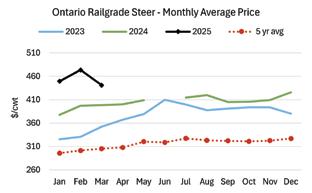
The market information section of our website can help you keep an eye on current market prices. For those without internet access, BFO provides a tapeline which is updated twice a day with the day’s auction market sale reports, railgrade prices, cattle futures and the Alberta and U.S. markets. This can be accessed toll free at 1-866-370-2333 or locally at 519-824-0334. Just dial extension 301 for the noon report and 300 for the night report or the rail report. The weekly report is available by regular mail also. Daily and weekly reports are available on the BFO website under Market Info at www.ontariobeef.com or via email or fax.






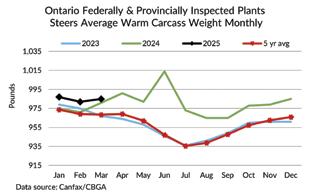







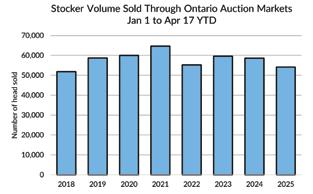
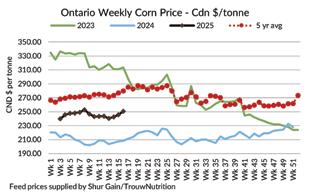


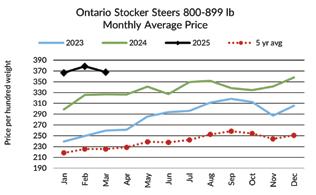

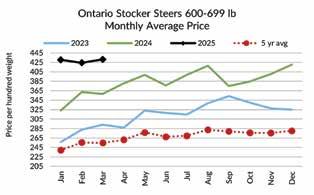

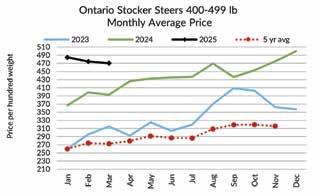

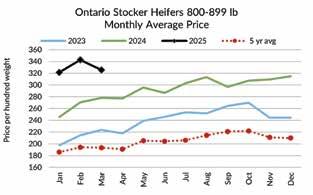
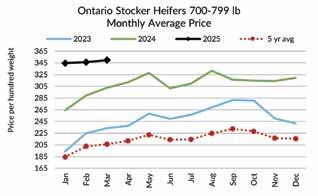

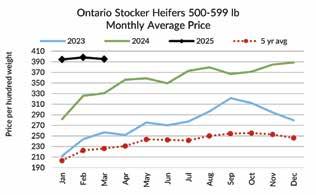
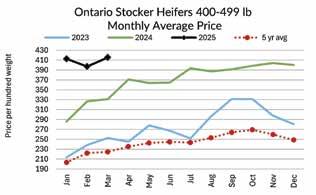
Once the disease has been identified, the appropriate treatment must be selected and administered. Your veterinarian will work with you to develop a protocol for treatment. When selecting the appropriate antibiotics and antiinflammatory drugs, consider the following:
• Antibiotic choice: Ensure the product is labelled for the disease being treated.
• Dosage: Calculate the volume of drug to give, based on the animal’s body weight.
• Route of administration: In muscle, under the skin, in the base of the ear, etc.
• Needle length: 1.5-inch for intramuscular (in muscle) and 1-inch for subcutaneous (under the skin).

• Dart compatibility: Darts can hold 6-10 mL of antibiotic. The drug must be non-viscous/thick to be given via dart.
• Meat withdrawal times: Consider drug withdrawal guidelines, especially with cull cows.
These considerations will help you to direct treatment for sick calves and cows on pasture and have an effective response to treatment. Prompt identification, restraint and treatment of cattle will give the best chance for treatment success.
Treating cattle on pasture doesn’t have to be complicated, but it does require planning, observation and a practical approach. Working with your veterinarian to develop pasture-specific protocols will help ensure timely identification, safe restraint and accurate treatment of sick calves and cows. Taking the time to plan ahead will minimize disruptions to your herd’s health and productivity, and ensures you’re ready to act quickly and effectively when issues arise. OB



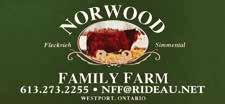

June 18-19 – Feedlot Management School, Bruce County. VIsit www.ontariobeef.com for details.
June 21 – Annual Meeting, Ontario Limousin Association at Boulder Cattle Co.
June 27-29 – Ontario Junior Hereford Association’s Beef-A-Rama, Erin
June 28 – Annual Meeting, Ontario Hereford Association, Erin
July 11-13 – Ontario Beef Youth Alliance (OBYA) Tour, Manitoulin Island. Visit www.ontariobeef.com for details.
July 16-19 – Canadian Shorthorn Association’s National Junior Show, Lindsay
August 22-23 – Cow-Calf Management Tour, Lennox & Addington and Frontenac Counties. Visit www.ontariobeef.com for details
September 9-11 – Canada’s Outdoor Farm Show, Woodstock, Ontario
September 16-20 – International Plowing Match and Rural Expo, Niagara Region
September 20 – Source for Success Hereford Sale, Indian River
October 5 – Quality Control Simmental and Angus Sale, Indian River
October 18 – Bluewater Angus Club 78th Annual Sale, Cargill






The Beef Farmers of Ontario (BFO) is committed to protecting the privacy and security of producers’ personal information in compliance with the Personal Information Protection and Electronic Documents Act (PIPEDA).
Subscribers to Ontario Beef magazine, the official publication of the Beef Farmers of Ontario, do so on a voluntary basis. By subscribing, subscribers are consenting to have their contact information used for the purposes of receiving the magazine and developing an BFO mailing list. This mailing list will be used for the distribution of the BFO magazine.
The BFO will not sell, trade or otherwise share its Ontario Beef mailing list under any circumstances. A service may be provided whereby items are submitted to the BFO and mailed internally with the magazine but all materials must be approved by and acceptable to the BFO. In rare instances where external, non-commercial organizations, like the provincial or federal government, wish to use the Ontario Beef mailing list to distribute information, the government must provide their mailing materials in a finished format to BFO and/or its mailing house. BFO will then coordinate the mailing, at the requesting organization’s cost, thus maintaining confidentiality of the list. In cases where the BFO may commission a mailing, the company providing the service is required to sign a mandatory confidentiality agreement.
Subscribers to the Ontario Beef mailing list who wish to have their names removed, should call 519-824-0334 or email info@ontariobeef.com. Please allow 15 business days to allow us to update our records accordingly.
BFO’s complete privacy statement, covering areas of information including the electronic update system, Website, membership list and market information can be viewed on its Website at http://www.ontariobeef.com/privacy.asp







By Lesley Kelly, Farmer and Co-founder of The Do More Agriculture Foundation
Asfarmers, we’ve always known uncertainty. From weather that’s out of our hands to fluctuating market prices, there are plenty of things that can make this job feel unpredictable. But in recent years, the landscape has shifted even more. Political tensions, trade wars, rising tariffs, and the unpredictability of global markets have added another layer of stress that feels a little harder to manage.
The back-and-forth between our trading partners, coupled with rising input costs and shifting demands, has left many of us feeling uncertain about what’s next. And that’s okay—those feelings are real. We can’t always control the decisions that are made in boardrooms or government offices, but we can take care of ourselves and protect our mental well-being through these times of stress.
Here’s a few tips on how we can navigate these tough moments together:
1.
One of the hardest things in farming is dealing with the things we can’t control. Trade policies, commodity prices, and global supply chain disruptions are all things that we know can impact our livelihoods but are completely out of our hands. It’s easy to feel frustrated, but instead of focusing on the things you can’t change, think about what you can control.
Take a look at your financials, and lean on your trusted advisor to explore risk management strategies.
Make a plan for different market scenarios, and look for ways to improve efficiency on the farm. It’s about doing the best with what’s within your power.
It’s important to stay informed, but we also need to protect ourselves from the constant negativity that’s out there. Too much time spent scrolling through news stories or social media posts about trade wars and market downturns can leave us feeling anxious and overwhelmed. Consider limiting how often you check the news, and take breaks when you start to feel the weight of it all.
Pay attention to the energy around you—spending too much time with negativity can drain you. Surround yourself with people who lift you up, even if just for a short chat.
3. Stay Connected
Isolation is real in agriculture, especially when the pressure is on. We all know how easy it is to retreat into ourselves when things aren’t going the way we want. But in those moments, staying connected with others—whether it’s other farmers, family, or friends—can make all the difference.
Reach out to local or online farming groups to talk about what you’re going through. Call a friend or a mentor who understands what you’re facing. Don’t hesitate to attend industry events or meetings, even if it’s just to feel connected to the bigger picture.
4.
It’s no surprise that our physical health directly impacts our mental health. Stress and uncertainty can take a toll on the body, leading to fatigue, sleepless nights, or even physical aches. Taking care of your body can give you the strength to weather the mental strain.
Make time for physical activity that you enjoy, whether it’s walking, stretching, or just moving around the farm. Be kind to yourself when it comes to rest—farming schedules are demanding, but sleep is crucial. Fuel your body with good nutrition and stay hydrated.
5.
It’s hard to open up, especially for those of us who were raised to be self-reliant. But struggling in silence only makes the weight heavier. Talk about what you’re going through, whether it’s to your spouse, a trusted friend, or even a professional. There’s no shame in reaching out—it’s a strength, not a weakness.
If you’re feeling overwhelmed, don’t hesitate to reach out to someone you trust. There are confidential hotlines and resources specifically for farmers, and they can help you find the support you need when you need it most.
6. Find Small Wins and Moments of Gratitude
When everything feels uncertain, it’s easy to get lost in the challenges. But sometimes, shifting our focus to the little victories can make a big difference. Take a moment every day to acknowledge something positive—whether it’s finishing a task on your to-do list, sharing a laugh with a neighbor, or simply watching the sunrise.
Step back and reflect on the things you love about farming such as the sunrises, taking care of the land and animals, working with family, and the pride in growing food that nourishes people.
Farming is a world full of uncertainty, but that doesn’t mean we have to let it take over our mental health. By focusing on the things we can control, staying connected with others, and taking care of ourselves, we can weather these tough times with strength and resilience.
You’re not alone in this. Your community is here to support you— whether that’s a neighbor, a friend, or a professional. Reach out when you need to, and don’t forget to take care of yourself, so you can keep moving forward. Agriculture needs you. OB





